Content [show]
Zinnia amazes with a huge variety of varieties, which attracts the attention of many flower growers. We have this plant better known as majors. Unpretentious in care, zinnia is capable of pleasing the eye with its abundant flowering for a long time and at the same time it is very unpretentious. Have you planted it on your site yet? Perhaps the problem lies in the choice? If so, we suggest that you consider the most popular varieties of this flower and make an informed decision.
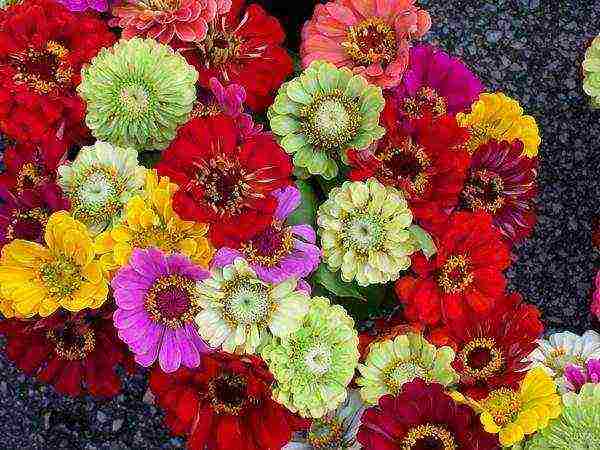 Zinnia is exactly the plant that can best decorate the site with minimal effort on your part.
Zinnia is exactly the plant that can best decorate the site with minimal effort on your part.
Zinnia is a plant belonging to the Asteraceae family. This flower owes its name to Karl Lineus, who in 1759 named it in honor of the director of the botanical garden, Johann Zinn.
Zinnia belongs to the genus of perennial and annual grasses, grows rather quickly and is a cross-pollinated plant.Depending on the variety, it can have an erect or spreading stem, or form a small bush. Ranges from 0.15 to 1.1 m in height. The strong, strong stem is covered with hard fibers. Elongated oval-shaped leaves sit on it, which are whorled or opposite.
On a note! The stalk of the zinnia is quite strong, which is why it does not need a garter (except for special weather conditions - strong winds or rainstorms), and cut flowers remain fresh for 1-1.5 weeks!
Zinnia is unpretentious, but in order for it to bloom as luxuriantly and abundantly as possible, it needs a lot of sunlight. For this reason, it is recommended to plant the plant in a warm, sunny area, protected from drafts. He does not like high humidity - watering should be rare, but at the same time abundant.
Bloom
Zinnia blooms incredibly effectively, forming complex large inflorescences at the ends of the stems. Their diameter can be up to 15 cm, and they consist of two types of flowers. The first type is the outer flowers, rather large, ligulate, their shape can be elongated-oval, elongated or in the form of a tube, which sometimes bifurcates at the end. The second type is tubular flowers. They are much smaller and generally tubular. They are located in the inner part of the inflorescence.
Zinnia flowers are extremely varied in color. They can be white, cream, red, scarlet, burgundy, orange, bright yellow, pinkish, purple, and even purple. Only blue is missing.
The flowering period of zinnia falls approximately 55-65 days after sowing in the ground and lasts until late autumn. Individual inflorescences are able to "live" for 3 days.
Garden classification
There are 4 main types of zinnias:
- graceful;
- narrow-leaved;
- fine-flowered;
- linearis.
Moreover, according to the garden classification, these species are divided into 3 subspecies: tall zinnias, the stem length of which is from 60 to 90 cm, medium-sized - from 0.35 to 0.55 m and undersized with a stem from 0.15 to 0.30 m.
Plants from the first subspecies are bred, as a rule, for a cut, and in general they look rather bulky in a flower garden. Low-growing zinnias are more versatile, as in the process of growth they form neat bushes, which are great for a flower garden, and for growing in pots, and for cutting.
 Low-growing zinnias produce the most colorful bouquets.
Low-growing zinnias produce the most colorful bouquets.
Graceful zinnia is the most common species and is most commonly grown for cutting. It has a powerful stem, large leaves and luxurious semi-double inflorescences measuring 12 cm in circumference.
On a note! The modern graceful zinnia has rather dense petals, which strikingly distinguishes it from the plant that appeared at the end of the 18th century. It had small inflorescences and it fully corresponded to its name - graceful!
Currently, zinnia graceful has a huge number of varieties, which are divided into separate groups.
- Dahlia (dahlia) zinnia. This is the most common group. Its representatives are characterized by large inflorescences - from 11 to 14 cm in diameter, and in the process of growth forms a large bush, which can be up to 1.2 m in height. In this case, the bushes are both powerful and spreading, and very compact. Dahlia zinnia, as you can see in the next photo, has tongue flowers with a rounded edge. They are located in the form of tiled masonry - they are found one on top of the other.
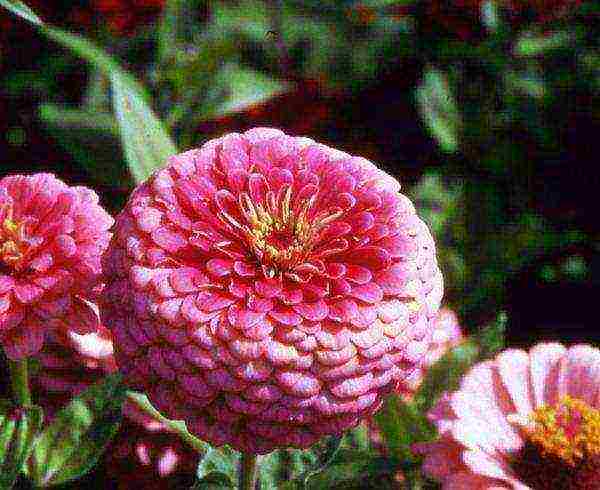 Dahlia zinnia has densely double inflorescences of a hemispherical shape, below the flowers are somewhat flattened
Dahlia zinnia has densely double inflorescences of a hemispherical shape, below the flowers are somewhat flattenedOn a note! Tall dahlia zinnias are striking in their beauty. Among them, the most famous varieties are Denariz Giants, Russian Size F1 and Zinnia California Giant. The diameter of their inflorescences is 15 cm, and the height of the stem reaches 1.2 m. The shade of the baskets can be varied, both monochromatic and two-colored.These varieties, like other tall zinnias, are grown for cutting, and they stand in water for up to 20 days.
- Chrysanthemum flowers. Such zinnias have a shorter stem - from 40 to 80 cm. Moreover, the size of their baskets is quite large - 8-16 cm. For varieties that belong to this species, the pure color of inflorescences is characteristic. Reed flowers are always twisted in length into a tube or curled like a curl.
- Pompom. Zinnias, which belong to this species, are usually bushy and bloom very profusely. They are frost-hardy and produce lush inflorescences from early summer to late October. It can take up to a month for a single flower to bloom.
- Fantasy. The plant is compact, neat, spherical in shape. It can reach a height of 0.65 m. The flowers are loose, 8-10 cm in diameter. The petals are narrow, sometimes bifurcated at the ends, can be curved or twisted, which is why the baskets look like "shaggy". Representatives of this variety can have a wide variety of colors. Flowering begins in mid-June and lasts until frost.
Zinnia angustifolia
The most unpretentious in cultivation and care is narrow-leaved zinnia. It has simple flowers, which in their beauty are in no way inferior to the above group. Their shade is often yellow or deep orange. The bushes are very beautiful spherical in shape, small and often their height does not exceed 0.5 m.
Narrow-leaved zinnia cannot boast as many varieties as graceful, and most representatives are very similar in appearance to marigolds.
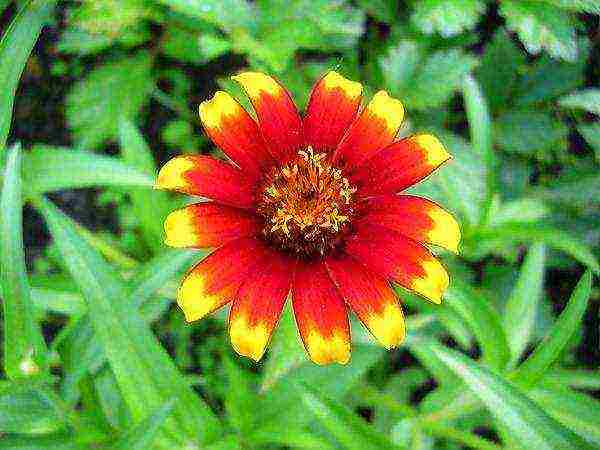 Zinnia angustifolia
Zinnia angustifolia
This type is most often found in landscape flower beds. Its bushes are small - up to 0.6 m in height. The stalk is thin, geniculate, and has a slightly reddish tint. Inflorescences are small - no wider than 3 cm, flowers are narrow with twisted ends. Their shade is usually purple.
In the next photo you can see what fine-flowered zinnia looks like.
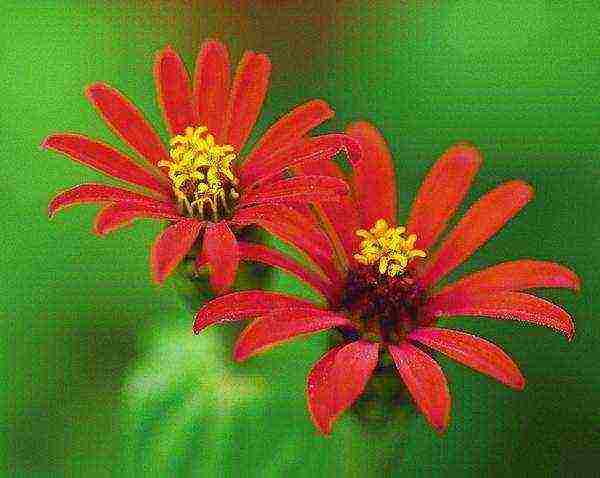 Variety "Red spider" Linearis
Variety "Red spider" Linearis
Quite often, zinnia linearis is confused with fine-flowered zinnia, since it has the same thin and sharp leaves. This species is one of the smallest of all cultivated. The branching bush has an almost spherical shape and grows no more than 35 cm in height.
During the flowering period, the linearis produces small inflorescences with yellow reed flowers. It is most suitable for growing in small containers or pots, and looks great on alpine slides and miniature flower beds.
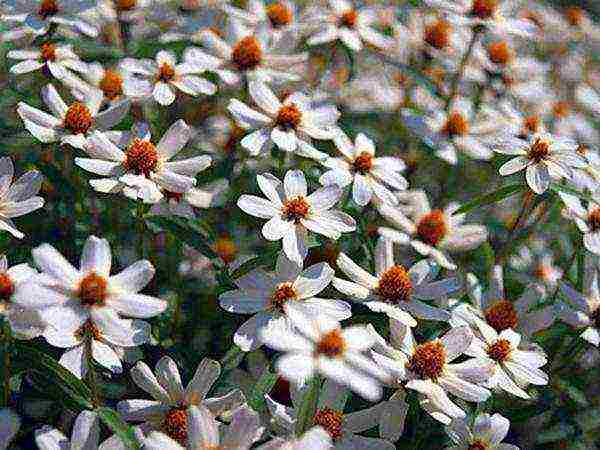 Zinnia linearis Popular varieties
Zinnia linearis Popular varieties
Represented by four main types, zinnia has incredible varieties, and therefore is easily able to justify the highest demands of modern landscape designers.
Undersized
Among the low-growing zinnias, you can find both an elegant variety and a narrow-leaved one. The following miniature varieties are very fond of many flower growers:
- Series "Lilliput" - double zinnia, which gives rather large (about 10 cm in circumference) dome-shaped inflorescences. The bush is of medium height - about 0.5 m. It blooms for a long time and profusely.
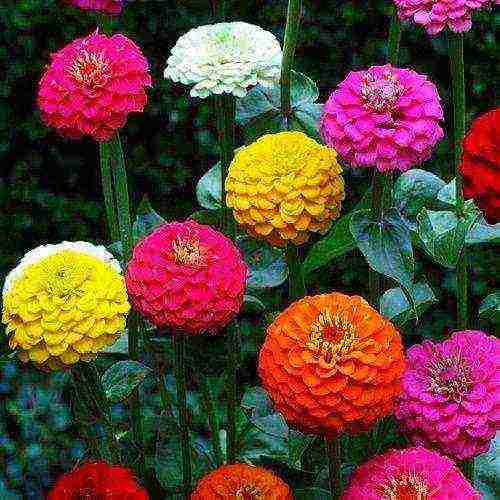 Zinnia "Lilliput"
Zinnia "Lilliput" - Rotcopchen, or Little Red Riding Hood, is one of the most sought-after varieties of graceful pompom zinnias. The plant got its name due to the dense red color of the petals, which, even under the strong rays of the sun, do not lose their saturation. "Little Red Riding Hood" is a short bush, the height of which can be 0.55 m and has a spherical shape. Covered with dense inflorescences - rounded or in the form of a truncated cone.
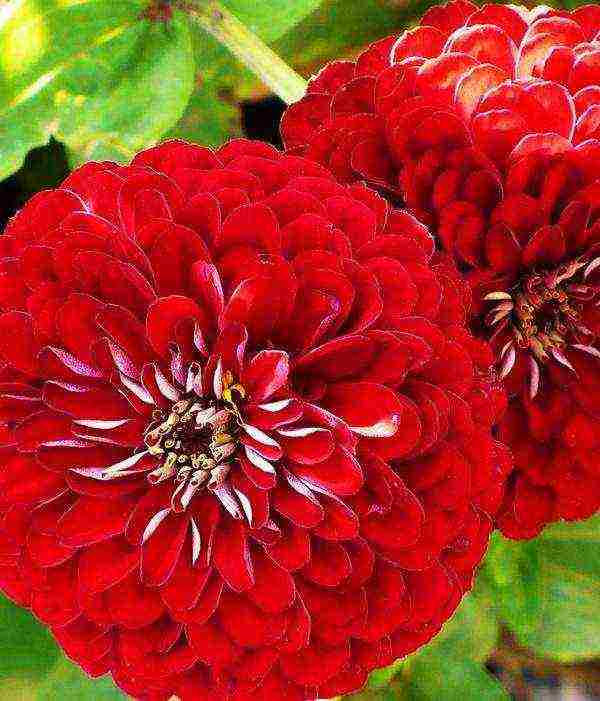 .Variety "Rotcopchen"
.Variety "Rotcopchen" - "Tom-Thumb", or "Tom-Tamb" - this flower also belongs to the variety of graceful zinnia. Its bushes are small, up to 45 cm in height, the flowers are bright red. This variety is very similar to the "Little Red Riding Hood", but its inflorescences are not so rounded - in this case, the shape is more flattened.
 Variety "Tom-Tamb"
Variety "Tom-Tamb" - "Short-Staff" - is one of the most popular representatives of undersized zinnias.The height of the bush is often no more than 25 cm, but at the same time the inflorescences give rather large ones - about 10 cm in diameter. Flowers can be of different colors: coral, cherry, red and white.
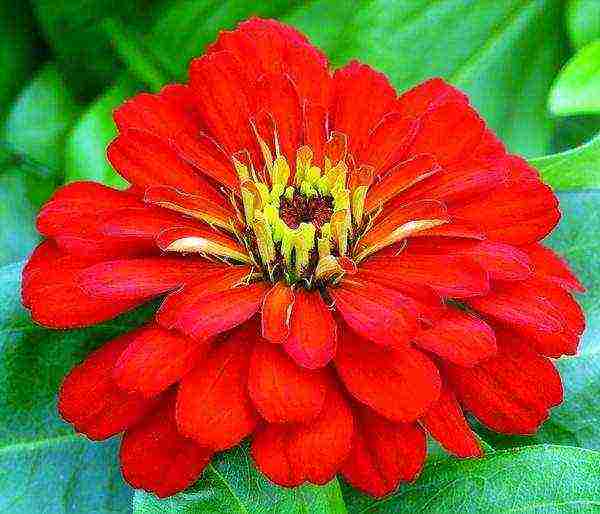 Variety "Short-Staff"
Variety "Short-Staff"
Dahlia Zinnia Varieties
Among the dahlia zinnias, the most popular are the following varieties:
- "Raspberry Monarch" - this variety gives an incredibly beautiful spreading bush, the height of which can be from 65 to 75 cm. During the flowering period, double inflorescences are formed, which can be either dense or loose. Their color is dark red, about 14 cm in diameter. A single flower can “live” from 17 to 26 days. The flowering period begins in early summer and lasts until the first frost.
 Variety "Raspberry Monarch"
Variety "Raspberry Monarch" - "Violet" is a sprawling bush, about 65-78 cm high. During the flowering period, dense inflorescences are formed, the diameter of which ranges from 11 to 13 cm. The inflorescences are terry, purple tones. It begins to bloom in July and this period lasts until frost.
 Variety "Violet"
Variety "Violet" - "Orange King" - the height of the plant is from 65 to 75 cm. The inflorescences are large, painted in a bright red-orange color. Their density is average, with a diameter of 13 to 15 cm. Flowers are double.
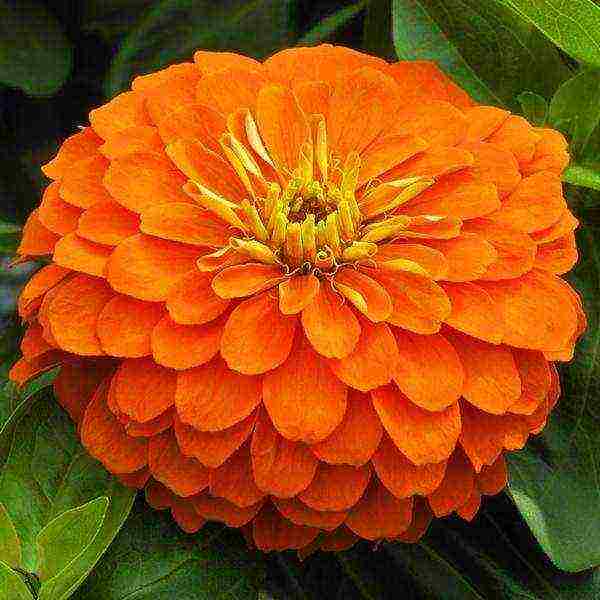 One flower can bloom for 20-24 days
One flower can bloom for 20-24 days - "Lavender Queen" is a relatively tall plant, about 0.85 m. Sprawling Kustranik, dense, double inflorescences, about 12 cm in diameter. The shade is purple.
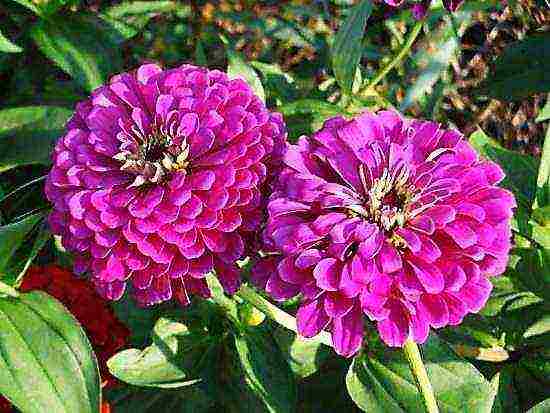 A single flower can bloom for up to three weeks.
A single flower can bloom for up to three weeks. - "Purple Prince" - the height of the bush ranges from 60-65 cm. During the flowering period, it gives large inflorescences with a purple tint. The flowering period lasts from the last decade of June to the first frost.
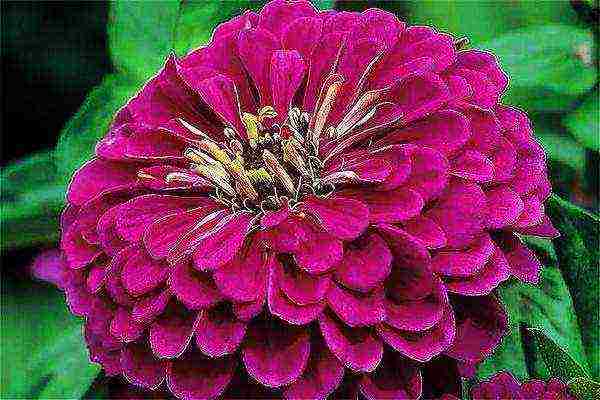 "Purple Prince"
"Purple Prince" - "Envy" is a plant about 70 cm high, the inflorescence circumference is about 12-13 cm. The most popular variety, which looks very advantageous in any flower bed, especially when surrounded by pink and purple flowers.
 "Envy"
"Envy" - "Polar Bear" is a medium-sized bush - about 66-69 cm. A compact plant with dense double flowers. The inflorescences are dense, 14-15 cm in diameter. Painted in white with a greenish tint.
 "Polar bear"
"Polar bear"
Varieties of zinnia angustifolia
The most common varieties of narrow-leaved zinnia are:
- "Persian Carpet" is a very beautiful plant, which in its appearance resembles an oriental carpet. The bush has a pattern composed of flowers of various colors: from bright yellow to deep brown.
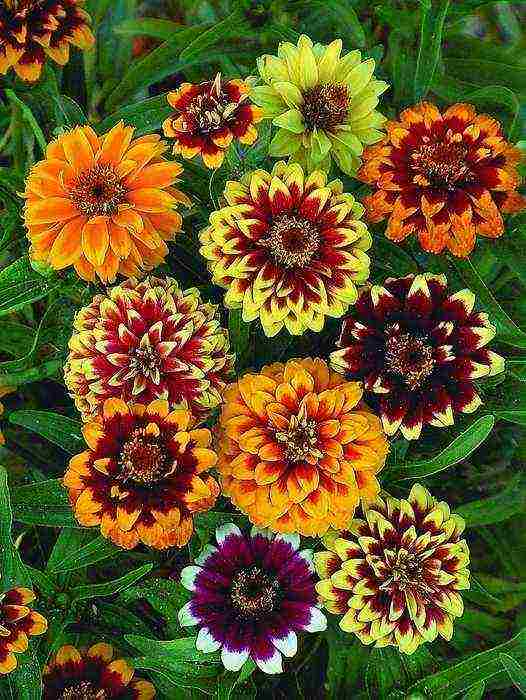 "Persian rug"
"Persian rug" - "Glorienshain" is a branched bush with double inflorescences. Blooms profusely, and throughout the entire flowering period. The flowers are bright orange, with a brown border visible at the tips.
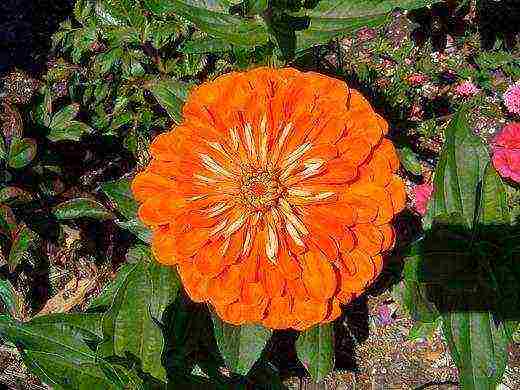 Glorienstein
Glorienstein - "CandyStrip" is somewhat similar to the "Persian Carpet" variety. He also has a second name "Tiger". The inflorescence petals are striped, which is why this plant looks great in a flower bed.
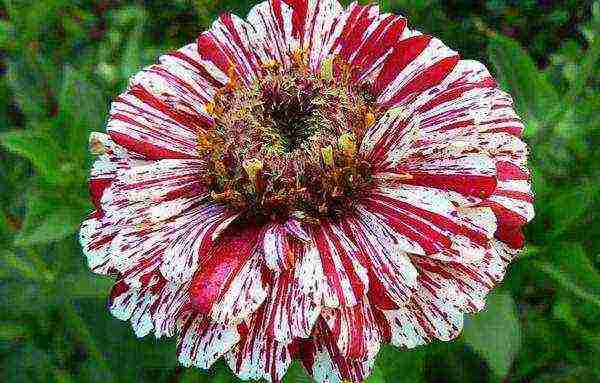 "CandiStrip"
"CandiStrip"
Hybrid varieties
The largest number of hybrid plants was obtained by crossing the graceful and narrow-leaved zinnia. Such a tandem gives very expressive bushes with incredibly lush dense caps and a bright pattern. Among the hybrids:
- series "ProfusionMixed" - plant height ranges from 30 to 35 cm. The bush is dotted with small flowers that are very similar to chamomile. However, their color may be different.
- Series "Carousel" - a medium-sized bush, about 60 cm high. Flowers are large, double, bicolor inflorescences. The petals are tapered at the ends.
- "Shaggi Dog" - small leaves twisted into tubes on the bushes. Leaves "look" down.
- "PepermintStick" is a very interesting hybrid, the petals of the inflorescences of which are painted in a bright yellow-red color.
- "Envi" - the bush has a fairly large light green foliage and a very expressive head of flowers.
- "Magellan" is a relatively small plant - about 35 cm in height. Inflorescences are densely double dahlia, their diameter is about 10 cm.The color is coral, pink, orange, salmon, cherry, red, yellow.
- The Swizzle series is represented by two varieties - Cherry Ivory, whose flowers have a creamy shade on the tips of the tongues, and ScarletYelow, with bright red flowers with a yellow border on the tips.
Bouquet varieties
Zinnia is a unique plant that can be grown both outdoors and in small pots right at home. It behaves well when cut, and under the right conditions will stand in a bouquet for two weeks.
On a note! Zinnia is good because it has a very weak aroma, and therefore will not cause discomfort to those people who are susceptible to a flower smell!
If zinnia interests you exclusively as a bouquet flower, then we advise you to use a mixture of varieties for cutting. Among the most successful species in this regard will be the aforementioned zinnia "California Giants". The bushes can reach a meter in height and will give you large inflorescences of various colors. Among the representatives of this variety, you can see white and yellow specimens, cream and purple, reds and lilacs, as well as all shades of pink and orange. Such a bouquet can stand for at least 12 days.
 "California Giants"
"California Giants"
Zinnia cactus is also the most successful choice. Her bushes are quite tall - about 90 cm, and the flowers are great for cutting. Large inflorescences are found on straight, strong stems. It blooms for a long time - from the beginning of summer to September, and stands for quite a long time after cutting.
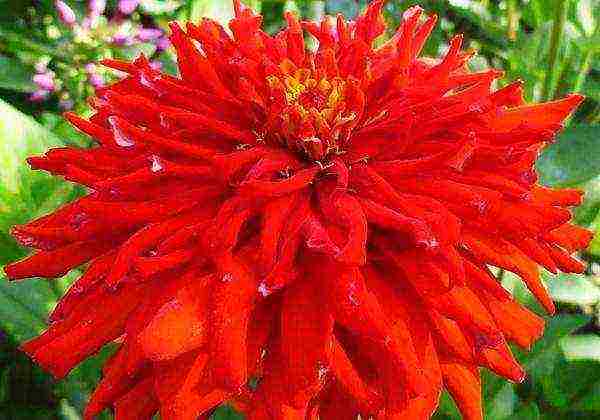 Zinnia cactus grade "God of Fire" Flower garden zinnia
Zinnia cactus grade "God of Fire" Flower garden zinnia
But be that as it may, the most successful zinnia still looks on a flower bed, as you can see by looking at the following photos. Among the flower garden varieties, the following are the most popular:
- Variety series "PersianCarpetMixed" - zinnia Hage. It gives amazingly beautiful semi-double bicolor inflorescences. Here you can find red-white, red-yellow, red-orange and red-lemon combinations. Often, plants from this variety series are grown in huge tracts that resemble beautiful variegated carpets from afar.
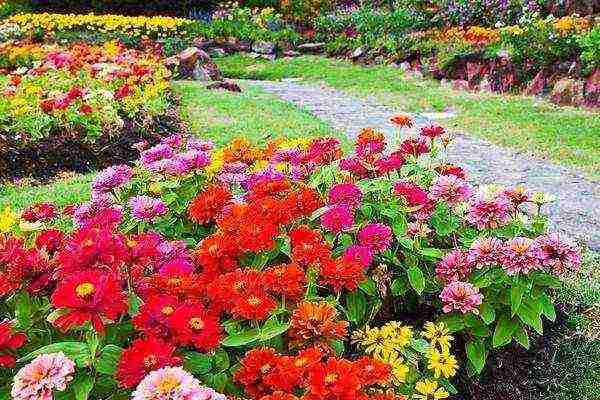 Picturesque flower bed with zinnias
Picturesque flower bed with zinnias - Any varieties of fine-flowered zinnia will look best in landscape flower beds. Its bushes with reddish stems and small flowers will be a real boon for all lovers of neat flower beds.
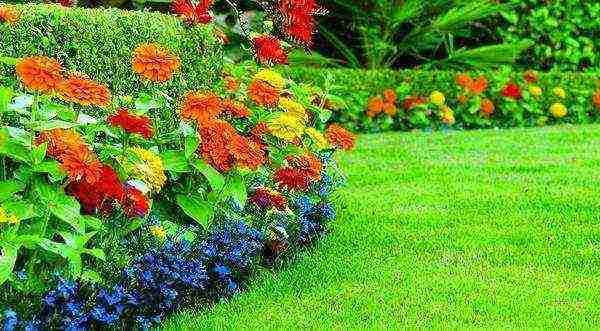 Garden decoration - long flower bed
Garden decoration - long flower bed - Zinnia Linearis is also suitable for growing in a flower garden, however it should be small. An alpine slide will be a great place for her. The most popular varieties for this case will be the varieties "Caramel" with a sharp center and dark yellow petals, as well as "Golden Eye" with small white inflorescences and a cheerful yellow center.
What's the best way to use zinnias?
Obviously, zinnia has a huge variety of varieties, which makes it easy to "fit" it into absolutely any landscape. At the same time, this flower can be placed in separate arrays: somewhere to create a picturesque carpet, somewhere to cover empty areas, somewhere to smooth out the transitions between cultures. And in any case, the zinnia will be in its place. What else to advise?
- Despite the fact that this plant looks great in a single planting, it is still better to place it in groups.
- If you are creating a mixborder, then tall varieties are best suited for it, but dwarf species are preferable for the border.
- Zinnia is able to recreate a rustic design by combining it with marigolds, asters, calendula, chrysanthemums and chamomiles.
- It can also be used to create a kind of "fence", for example, by planting bushes in a row between vegetables and herbs. So you get a bright spot on a somewhat "sad" garden background, which will perform not only a decorative function, but will attract pollinating insects.
- It is quite possible to plant zinnias along the path leading to your house, as well as around the garden building.Such linear plantings diversify the overall landscape picture and bring bright scenic notes to it.
Moscow, Russia, on the site since 11.01.2017
Have you read it? Don't forget to rate
(
estimates, average:
out of 5)
Types and varieties of zinnia
Similar articles
About a month after planting, but long before the flowering itself, the first feeding of the culture is done. Urea and any of the organic fertilizers are diluted in water (for 10 liters - one tablespoon of urea + fertilizer).Growing a plant is quite simple, as when planting and caring for a hosta, although little whims are inherent in the flower. Zinnia reproduces only by seeds that are afraid of frost and die already at a temperature of -1̊ C. Therefore, sow seeds in open ground, making sure that frosts will not return.New Burpee's Hybrids - very large inflorescences (diameter 13-15 cm) yellow, red, pink, carmine, salmon. Plant height up to 70 cm. Likes: Zinnia planting and careZinnias, a mixture of varietiesThe minimum of worries is the maximum return. The unpretentious zinnias will delight your eyes without having to take care of them with all your might.Numerous hybrid varieties have been produced. Specifically the Desert Sun Mixed seriesDahlia,In decorative floriculture, varieties of graceful zinnia are most often used. This is the most famous species, especially popular for cutting. Strong hollow stems, large leaves and semi-double inflorescences (in some varieties up to 12 cm in diameter) with dense shiny "petals" - everything is very solid and not at all like that really graceful zinnia with small inflorescences that appeared in Europe at the end of the 18th century When budding, a second feeding is carried out When growing zinnia, there are a couple of important rules. It is required to remove decaying and faded inflorescences, especially in wet weather, and treat the plant with fungicides at the end of August.Scabioza (anemone) - plants about 60 cm high, inflorescences-baskets of various colors.Major. Zinnia. Zinnia.for which you will carry out, we have described using the example of the following According to the structure of the inflorescences, the shape of the reed flowers and the height of the zinnias, they are divided into several groups: dahlia, chrysanthemum, scabioza, gaiardio, pompom, fantasy.A feast for birds and butterflies. Plant some zinnias and watch your garden come to life with a host of winged creatures.Profusion Mixed is available in all shades of yellow and orange. The balls of sunny inflorescences do not create a feeling of massiveness, therefore, the variety is quite suitable for a mixed border of summer houses, as well as for a "fence" or for a flower bed. It is better to look at them from some distance or from above, for example, from a balcony. Bright and joyful, they are able to cheer up even on a gloomy day.
There are 4 types of zinnias in modern catalogs:
- ... For 10 liters of water, you will need 1 tablespoon of liquid fertilizer, which can be purchased at any flower shop.
- Since perennial zinnia is too capricious plant when planting and leaving, then summer residents are most popular about
- The new Attraction - in the center of the basket - is a "pillow" of overgrown tubular flowers, surrounded by one row of wide reed flowers in the form of a cuff. This inflorescence is called anemone, or scabiose. Plants about 60 cm high, baskets of various colors.
Most of the zinnia species came to Europe from Mexico, where they were cultivated even before 1520. In Europe, zinnia appeared only in 1750, where it was nicknamed - "the flower of the poor." Zinnia easily multiplied, its cultivation did not cause any difficulties for Europeans, and therefore the flower was available to everyone.Zinnia species In Russia, the most common varieties of dahlia and pompom zinnias, less often they use varieties of the fantasy group.
Endless flowering. The more flowers you pinch off the zinnia, the more flowers will form.
- bushes 30-35 cm high, covered with small multi-colored "daisies". Among the new varieties we will nameAnother well-known species, suitable exclusively for flower beds, isScabiosa,
- Graceful
- After opening the buds, they can be sprayed with the "Bud" preparation (for 10 liters of water - 10 g). Then feeding is carried out at your request, there is no urgent need for them. It is important not to go far in fertilizers with nitrogen (due to its large amount, the stems can rot).
- Annual species: narrow-leaved and graceful
- Fantasia (Fantasia) - almost spherical bushes, 50-65 cm tall, compact. ... The inflorescences are terry, loose, 8-10 cm in diameter, the ligulate flowers are narrow, sometimes bifurcated at the ends, twisted or curved, so the baskets seem shaggy. There is only one variety-population in this group, but its representatives have a variety of colors. Flowering inflorescences 16-22. Blooms from mid-June until frost.
- Cynia was once called "youth and old age" for its ability to produce new flowers, while the old ones have not yet faded. In Russia, for its gallant appearance and dapperness, zinnia received the name "major", in Kazakhstan - "major", in Ukraine it is called "major".
- ... They go well with any flower planting scheme.
- Most often, seeds are sold in a mixture, although recently, with the development of the culture of landscape gardening, the need for seeds, divided by varieties or colors, has increased.
Zinnia
Swizzle Scarlet and Yellow Zinnia Hage
Gaiyardiotsvetnye, (Many gardeners recommend sprinkling the soil with wood ash before feeding.. They became the basis for breeders when breeding many varieties of zinnia. Recently, new wonderful varieties and hybrids have appeared: Often called zinnia “Grandmother's flower.” These beautiful and unpretentious plants were grown by our grandmothers. The fashion for flowers is returning, and zinnia is again becoming in demand. Now in almost every garden you can see this bright annual. Elegant, attractive zinnia adorns the flower garden with spectacular multi-colored all summer and half of autumn With little to no return, zinnia delights the eye with splendor until mid-October Zinnias are especially popular in the US Most modern varieties were bred there. - Bushes are powerful, spreading or compact, 60-90 cm tall, with a small number of first-order shoots. The leaves are large, up to 12 cm long. Inflorescences are hemispherical, large, 10-14 cm in diameter, terry. Ligulate flowers are elongated-lobed, arranged in tiles with slightly raised edges. (
And (
Pompom (lilliputian), Zinnia elegans If you fulfill all these simple requirements for planting and caring for zinnia flowers, then, rest assured, a wonderful plant will thank you in full.
Photo of a narrow-leaved variety of the Colossus flower - a very majestic zinnia, growth (100-125 cm). Plants are powerful, branchy from the base, do not need a garter. Huge double inflorescences 10-13 cm in diameter flaunt on long, strong stems. Blooms from June until frost. In the garden, it is better to place in separate groups, since this plant overshadows less spectacular plants with its richness and richness of colors. Ideal in vases Zinnia belongs to the Asteraceae family. The name was given to the plants by Karl Linnaeus in 1759 in honor of Johann Gottfried Zinn (1727-1759), professor of pharmacology, director of the botanical garden in Göttingen, who provided Linnaeus with herbarium material for his work. zinnia should be planted after spring frosts. Planting zinnia seeds is carried out in the middle - end of April, they germinate quickly in 5-7 days, after the emergence of shoots, the sprouts are placed closer to the sun.Sprouted flowers should be watered regularly when the topsoil dries out. Dive should be carried out at the moment of full development of the first true leaf. The roots should be shortened deeper by 1/3, in which case they will branch better. Cotyledon leaves should not be covered with soil.
Zinnia graceful, grade 'Envy'
Swizzle Cherry and Ivory Z. haageana cactaceae,), well-groomed perennials
All crop varieties are divided intoCarousel is a very elegant variety with red "petals" with cream or yellow tips (height up to 60cm). Low zinnias, especially F1 hybrids, more than tall ones with large baskets, are suitable for flower beds. We give a description of some varieties that are already cultivated in the conditions of central Russia.This is a fast-growing annual herb, cross-pollinated plant, forms an erect, spreading or compact bush, 15 to 110 cm high (sometimes even higher). 10 days after the pick, you need to fertilize with complex mineral fertilizers. Some varieties of dahlia zinnia ) Is a genus of annual and perennial grasses and dwarf shrubs of the Astrovye family (which we meet under the name “
). The most famous variety seriesFantasy.Narrow-leaved sowed seedlings, then on a flower bed, they grew up beautifully, huge, bright, beautiful. Their shallow root system became a problem. When the torrential rains started, the bushes became heavy and began to collapse with upturned roots. I think it was necessary to remove some of the stepsons, like a tomato, so that the bushes grow more compact. I had to prop it up. The seeds did not match up a bit with what had grown. On the package, dwarfs were promised, and whole generals grew up (I remembered that sometimes zinnias are called majors). But in general, I was satisfied and this year I bought new varieties.:
Magellan (Magelan). Plants 25-35 cm high with densely double dahlia inflorescences (diameter 9-10 cm) of various colors (cherry, coral, creamy white, orange, pink, red, salmon and yellow).Stems are powerful and strong, covered with hard hairs. Strong stalks of zinnia do not need a garter, and cut flowers stand in water for 7-10 days. Leaves are oblong-oval, sessile, opposite or whorled on the stem.Seedlings of zinnia Violet (Violett) - Sprawling bush, 60-75 cm tall. The inflorescences are terry, dense, 9-12 cm in diameter, purple, of various shades. Flowering inflorescences 18-23. Zinnia 'Violet' blooms from mid-June until frost.CarouselPersian Carpet Mixed In Russia, the most common varieties of dahlias and pompoms, less often plants of the fantasy group are used. (Zinnia flower (zinnia) is a plant of the Asteraceae family, growing in Central America, Mexico. This is mainly a flower bed plant, but to grow Zinnia can be successfully done at home. Zinnia is very thermophilic, loves bright light and space around itself, so when growing, try to provide free space within a radius of half a meter around the flower pot. It also needs nutritious soil, which will make the inflorescences more vibrant and vibrant. the variety of species and varieties of zinnias, which have different shapes, sizes and colors of inflorescences, is important.You can find red, bright yellow, pink, orange zinnias.Also, separately you can mention the existence of cactus, dahlia-like, mossy varieties of zinnias.high (from 60 up to 95 cm), Peter Pan. Plants 30-35 cm high, densely double inflorescences about 10 cm in diameter, light and dark pink, bright red, crimson, orange, orange-red, yellow, cream and pure white For abundant and lush flowering, this plant needs a warm, sunny area protected from the wind, responds well to watering.Not picky when transplanting, it quickly grasps the soil and normally grows.The land for it must be rich, before the plant blooms, it is necessary to apply mineral fertilizers 1-2 times.Crimson Monarch - Sprawling bush, 60-70 cm tall. The inflorescences are terry, dense, sometimes loose, large, 11-13 cm in diameter, dark red. Flowering inflorescences 18-25. Blooms from mid-June until frost.
).". These are plants 60 cm high with large double, bicolored inflorescences, the "petals" of which are tapering at the ends, like, With semi-double, bicolor inflorescences (red - with white, yellow, orange, lemon). This mixture is most often planted in large tracts, and it really resembles variegated oriental carpets.DahliaZ. angustifolia Zinnia growing and nursing medium (from 35 to 50 cm), Swizzle. Plants 25-30 cm high, double inflorescences 8-10 cm in diameter Desirable soil light, fertile, permeable, with a neutral reaction Zinnia photo Lavender Queen (LavenderKonigin) - Sprawling bush, 65-80 cm tall. Inflorescences are dense, double, 10-12 cm in diameter, lavender with a purple tint. Flowering inflorescences 19-23. Zinnia Lavender Queen blooms from mid-June until frost The genus of zinnia has 15-20 species native to Central and South America.For landscape flower beds, they usually choose
- powerful, sprawling or compact bushes 60-90 cm high. The flowers are ligulate, with a rounded edge, they find one on top of the other like a tile, the inflorescences are densely double. Cut zinnias retain their freshness and cost better than dahlias.
), Or
Optimal temperature: these flowers need warmth, therefore, keep the temperature in the room at a level of 24-26 0С. Lighting: for the successful development of the plant, bright lighting is necessary, give it a spacious, sunny place in the room. Air humidity: spray the flower once a week. Watering: medium abundance of watering is preferable, without creating over-watering. If growing your plant outdoors, watch for changes in air temperature and adjust watering accordingly. Fertilizers: Fertilize the plant with mineral fertilizers once or twice a month. Soil Composition: Use a turf soil with a small amount of leafy soil and peat. Bloom: bloom in summer and autumn. Lifespan: is an annual plant. Difficulty of development: it is quite simple to grow zinnia both in indoor and in garden conditions.
Low or dwarf (no more than 30 cm).
The series includes 2 two-color hybrids:
Zinnia flower
For zinnia, you should choose a bright place, and most importantly a warm one, provide protection from the wind. Zinnia blooms 2-2.5 months after the appearance of the first shoots, it can bloom before the first frost. Zinnia begins to turn black only at -1 degrees. The peculiarity of this flower is drought resistance. If the lack of moisture is long, the inflorescences become smaller, the decorativeness of the plants deteriorates. Wet weather has a rather detrimental effect -
Zinnia cultivation
Orange King (Orange Konig) - Sprawling bush, 60-70 cm tall. Terry inflorescences, medium density, large, 12-14 cm in diameter, bright red-orange. Flowering inflorescences 18-23. Blooms from late June until frost.
Planting zinnia seeds
Zinnias are annual and perennial, herbaceous and semi-shrub plants. Leaves are ovate with a pointed apex, sessile, whole, opposite or whorled on the stem. Inflorescences are baskets, solitary, relatively large, apical, on long, usually from above, thickened peduncles or sessile. The wrapping of the baskets is multi-row, tiled. The marginal flowers are ligulate, variously colored: yellow, red, white, pink, purple, lilac, densely arranged, with a rounded or notched limb; internal - small, tubular. Zinnia fruit is achene.
Planting zinnia in open ground
Motley zinnia
Zinnia fine-flowered
There are varieties with a rare color of inflorescences: carmine - "
Hage
Zinnia reproduction and growth
Zinnia care
Tall zinnia, like heather, about the medicinal properties of which you can read here, is grown for cutting
- Cherry Ivory with cherry baskets and creamy petal tips,
- Zinnia blooms are extremely effective. The complex inflorescences of zinnia are large, up to 15 cm in diameter, consist of 2 types of flowers: the outer ligulate flowers are large, in shape they can be elongated-oval, linearly elongated or curled lengthwise into a tube, sometimes bifurcated at the end. Inner flowers are tubular, small and narrow. The lingual flowers of zinnia are female, tubular (located in the center of the inflorescence) are bisexual.
- Zinnia flowers
Polar Bear - she is Zinnia Polar Bear or, in another spelling. The bush is compact, 60-65 cm tall. Inflorescences are densely double, dense, 12-14 cm in diameter, white with a slight greenish tinge. Flowering inflorescences 17-20. Blooms from mid-June until frost.
Semi-double, orange zinnia
- (
- Crimson monarch
- (
- Zinnia seeds are the only way to reproduce. It is very easy to grow zinnia from seeds. To do this, at the beginning of April, the seeds are sown, depending on their number, either in oblong boxes or in ordinary pots. When they sprout, they need to be planted in separate pots or planted in a flower bed. Provide a distance of 30cm between the seedlings. You can plant several plants in a pot, preferably no more than 3. In the case of flower beds, planting zinnia should be carried out in early summer, when the air is already warm enough. For more information on reproduction, see Reproduction of plants (Sexual reproduction of plants> Reproduction by seeds).
- ... Flower lovers do not indulge this variety too much due to its bulkiness.
Scarlet Yellow (Scarlet Yellow) with red inflorescences and bright yellow tips and "petals".The color of flower baskets is unusually diverse: white, yellow, pink, orange, violet, lilac (there is no only blue) .begin to rot. In damp cold weather, the baskets often rot, so as not to reduce the decorativeness of the plant, you need to pinch off the faded baskets Purple Prinse - The height of the bush is up to 60 cm, with large purple inflorescences, blooms from late June until frost. gardening uses two annual species - Zinnia is a very long-flowering flower, while very bright and beautiful. This flower is very fond of various pollinating insects:
Z. tenuiflora
Description of zinnia
", Lilac -"
Z. haageana
Diseases and problem momentsBranching lush bushes of low-growing varieties of zinnia are versatile and decorate flower beds as a pot or container culture. In addition, they are resistant to the wind, and with good care they bloom continuously and richly.These zinnias are more suitable for containers and balconies. When grown outdoors, they need a sunny spot with light, drained soil.Zinnia blooms 55-65 days after sowing and continues to bloom until late autumn. Individual inflorescences have a lifespan of 34-35 days Seeds are tied in large numbers, but develop gradually, begins to ripen 60-65 days after flowering, so in our conditions it is very difficult to get ripe zinnia seeds. You can accelerate the development of seeds if you leave 1-2 inflorescences, removing all lateral shoots. AnyRose (Rosa) - Sprawling bush, 50-65 cm tall. The inflorescences are terry, medium-dense, large, 10-12 cm in diameter, pink in various shades. Flowering inflorescences 15-20. Blooms from mid-June until frost.Zinnia graceful Bumblebee on a zinnia flower) - bushes about 60 cm high with thin, geniculate, reddish stems. This plant has small (up to 3 cm in diameter) inflorescences, "petals" are narrow, bent outward, with twisted tips, dark red.
Growing and caring for zinnia
Dream
),
If the tips of the leaves of the plant begin to dry out, pay attention to the humidity of the air and soil; for a while, you can put the flower pot in a shaded place. Plant treatments are described in the sections: Plant Pests and Plant Diseases.
The low grade is also cut off - they make up unique colorful compositions
Short Staff. Plants with a height of 20-25 cm are the most compact and lowest zinnias for open ground. Terry baskets (diameter 9-10 cm) coral, dark red, yellow, orange, cherry and white.
In nature, 22 species of zinnia are known, but usually only two are grown - graceful zinnia and narrow-leaved zinnia, or Hage. These two species gave rise to numerous varieties.
Planting zinnias
Flower planting scheme
Tango (Tango) - Semi-spreading bush, 60-70 cm tall. The inflorescences are terry, loose, large, red-orange, 9-11 cm in diameter. Flowering inflorescences 18-28. Zinnia 'Tango' blooms from mid-June until frost.
(
The use of zinnias in garden design
Bright red zinnia
The smallest cultivated zinnia -
Varieties and types of zinnias
Zinnia graceful (Zinnia elegans)
", Coral pink -"
Fine-flowered
Zinnia photo
... Before freezing, zinnia of a stunted type can be moved to a large flowerpot and left in the house on the windowsill on the south side. The flower will delight for several more weeks.
Zinnita. Plants 15-20 cm high are good for growing in pots and containers, suitable for seedlings during the summer. Terry pompom inflorescences (diameter 3-5 cm), yellow, orange, pink, bright red and white.
Dahlia group of graceful zinnia varieties
Zinnia graceful is more popular. Currently, there are many varieties of it. According to the structure of the inflorescences, the shape of the reed flowers and the height of the plants, they are divided into groups: dahlia, chrysanthemum, scabio, gaiard, pompom (lilliputian), fantasies. In floriculture, the most common varieties are dahlia and pompom, less often varieties of the fantasy group are used. Flowering is profuse and prolonged from mid-June to frost. Fruiting, the fruit is achene, rather large, lanceolate.
It will look more expressive with them.
Cherry Queen - Bush height up to 70 cm, with large dark cherry baskets blooming from mid-June to frost;
- Zinnia elegans
- Photo white zinnia
- Zinnia linearis
- Hallo
- (
- Zinnia varieties and types
- The varieties of terry zinnias in the photo are gorgeous, like roses, but it should be rightly noted that zinnia with a simple basket blooms more abundantly and has its own charm, and also tolerates adverse conditions much more firmly.
- Narrow-leaved zinnia, or Hage (Zinnia angustifolia).
- Dahlia - one of the most common zinnias - plants are distinguished by a high bush from 60-120 cm and large inflorescences 10-15 cm in diameter.
- Tall zinnias are rich in good cutting material that can be stored in water for a long time, medium ones are used for decoration with other flowers, undersized ones are used in borders, flower beds, flower beds, for planting on balconies, in hanging vases, pots and other flower planting schemes in flower beds.
- Purple (Scharlach) - Sprawling bush, 60-80 cm tall. The inflorescences are terry, loose, large, 10-13 cm in diameter, bright red with an orange tint. Blooms from mid-June until frost.
) And
Pompom group of graceful zinnia varieties
To enlarge the photo in full size, just click on the image. Also, these photos can be used as a desktop screensaver.
(
- "And purple, iridescent with a bluish tinge -"
- Z. tenuiflora
- Zinnia terry
Terry zinnia in the photo
Zinnia angustifolia
Plant height 20-40 cm. The shape is spherical, compact, the stems branch at the very base. Leaves are sessile, elongated or lanceolate, pointed, up to 6 cm long, with a wide base.Numerous small stellate inflorescences-baskets, up to 4-6 cm in diameter, simple or semi-double, monochromatic, yellow, orange, red-brown, often bicolor with spots, rings or border. Zinnia narrow-leaved looks more modestly graceful and in appearance resembles low marigolds. Flowering in zinnia angustifolia is abundant and long - from late June to frost. Fruiting, the fruit is achene, rather large, lanceolate. Known in culture since 1862. Zinnia Persian carpet is a mixture of seeds of Zinnia angustifolia.
The leaves are large, up to 12 cm long. Inflorescences are hemispherical, large, 10-14 cm in diameter, terry. Ligulate flowers are elongated-lobed, arranged in tiles with slightly raised edges.
Some varieties of zinnia angustifolia
Zinnia photo
Envy - The height of the bush is 60-70 cm, with double green inflorescences with a diameter of 10-15 cm. The most unusual and, probably, the most popular variety of zinnias at the present time. Blooms from mid-June until frost. It looks especially advantageous against a contrasting background of pink and purple tones.Zinnia angustifoliaGrowing zinnia is not such a time-consuming business that even a novice gardener can handle. However, there are still various nuances, mowed soil, plot, sowing. And we will try to analyze all of them in detail.
Zinnia planting and care
Z. Linearis
Purple prince) AndZinnia midgetUnlike double varieties, which suffer from inflorescence rot during the rainy season, zinnia with simple flowers shows better development. Also, simple zinnia will suffer less from strong winds compared to terry zinnia. Zinnias planted in a group or in a company with anemones grown from tubers will look much more attractive.Growing zinnia
Lavandelkonigin - Sprawling bush, 65-80 cm tall. The inflorescences are dense, double, 10-12 cm in diameter, lavender with a purple hue. Flowering inflorescences 19-23. Blooms from mid-June until frost. Crimson Monarch - Sprawling bush, 60-70 cm tall. The inflorescences are terry, dense, sometimes loose, large, 11-13 cm in diameter, dark red. Flowering inflorescences 18-25. Blooms from mid-June until frost.
Planting zinnia seeds
The palette of the summer garden, rich in rich colors, helps flower growers create decorative zinnias belonging to the Aster family. Seeing the variety of zinnias, it seems that nature has tried to put all the bright and rich colors of summer into one flower.
Zinnias, ‘Queen Red Lime’ and ‘Queen Lime’(Zinnias reproduce by seeds. Sowing seeds should be done in early April, like ordinary seedlings. It is best to germinate the seeds in a damp cloth before sowing. Usually, sprouts appear in 2-4 days. You can plant seedlings in any container, 1 centimeter per gubina. After planting, it is advisable to cover the container with a dark film, this will speed up the germination.
). Sometimes this particular species is represented as
Zinnia care
". The height of these plants is 80 cm, the inflorescences are huge, the size of a saucer - up to 12 cm in diameter.LinearisZinnia graceful
The flower is traditionally bred1. In the southern regions, seeds are embedded directly into the ground. The best time for sowing seeds is the beginning of May. Podwinter crops do not germinate. The seeds are buried in the soil to a depth of 0.6-0.7 cm. Zinnia seeds germinate in the soil in 4-7 days. With a seedling length of 7-10 cm, planting must be thinned, the distance between plants is from 15 to 45 cm (depending on the variety). Zinnias need good air circulation. Young seedlings are very sensitive to frost and die at 0 degrees Celsius. Growth and development proceeds rapidly under favorable weather conditions. Flowering begins in early July and continues until frost.Violet (Violett) - Sprawling bush, 60-75 cm tall. The inflorescences are terry, dense, 9-12 cm in diameter, purple, of various shades. Flowering inflorescences 18-23.Blooms from mid-June until frost.
If you plant different varieties of this plant on your site, then from mid-summer until October you will observe pale pink, fiery red, yellow, orange, white, purple, lilac and even variegated two-color flowers. MirSovetov invites readers to try to grow these plants in their flower garden or on a flower bed in the yard of the house.
Pomponny zinnias - bushes 40-55 cm tall, compact, densely branched, with a large number of shoots of the second - fourth order. The leaves are small. Inflorescences are cap-shaped, round, small, 3-4 cm in diameter, very dense, terry. Ligulate flowers are small, tiled. Abundant flowering, simultaneous.
Zinnia angustifolia
|
In open ground, zinnia should be planted when the threat of frost has completely passed. Popular species and varietiesZinnia angustifolia
This plant comes from Mexico. The name was invented for him in 1759 by Karl Linnaeus, giving it in honor of the professor of pharmacology John Gottfried Zinn, who worked for some time as director of the botanical garden in the city of Göttingen. This man kindly provided herbarium materials for Linnaeus's work. Let's say right away that it is permissible in Russian to spell the name of this flower with either one letter "n" or two. About 22 types of zinnia can be found in nature, but only two of them are cultivated on their plots by flower growers - graceful and narrow-leaved. Most varieties are bred by US breeders. The height of the graceful zinnia varieties ranges from 20 to 120 cm, and the diameter of the flowers is from 3 to 16 cm. The color range is varied, there are only varieties with blue flowers. The leaves of the plant are lanceolate or oblong, bright green, heavily pubescent with hairs. All varieties of graceful zinnia varieties can be divided into several groups: Some varieties of pompom zinnia Growing methods), Which gave rise to numerous varieties of garden zinnias and which are very diverse in decorative possibilities. Zinnias are especially popular in the United States. Most of the modern varieties were bred there. Americans love it for its heat resistance and bright color. First, let's say a few words about soil. It should be neutral in acidity and sufficiently enriched with organic fertilizers. How to treat zinnia?( - the petals of these zinnias are twisted a little lengthwise, so their inflorescences could be called “needle-like”. |
| Z. linearis |
Major. Zinnia. Zinnia
Zinnia dahlia
Zinnia
.
In early June, zinnias are planted in open ground. Tall varieties - at a distance of 30-35 cm, medium-sized - 15-20 cm, dwarf - 12-15 cm. After planting, until the plants take root, they are regularly watered.Adult zinnias also easily tolerate a transplant with a clod of earth. Hardened seedlings and flowering plants tolerate frosts down to -1C, no more.
(Polar Bear) - Compact bush, 60-65 cm tall. Inflorescences are densely double, dense, 12-14 cm in diameter, white with a slight greenish tinge. Flowering inflorescences 17-20. Blooms from mid-June until frost.
Zinnia plant
Dahlia-flowered - their flowers are large (up to 15 cm in diameter), and the height of the peduncle sometimes reaches 60-120 cm. The Crimson Monarch variety has bright red flowers, while Illumination has intense pink, Violett (purple ), Lavendel (purple), Isabella (bright orange), Fatima and Golden Doon (golden yellow), Polar Bear (white with a greenish tint). There is also a variety called "Carousel".
Little Red Riding Hood (Rotkappchen) - Bush densely double, almost spherical, 45-55 cm tall. Inflorescences are densely double, dense, 3-5 cm in diameter, from truncated-conical to almost rounded, bright red, do not fade in the sun. Flowering inflorescences 65-75. Blooms from late June until frost.
Zinnia is a light-loving and heat-loving plant that does not tolerate frost. For abundant, long-lasting flowering, requires soil with sufficient nutrients and a neutral reaction. The plot allocated for the cultivation of zinnias is first dug up, and then humus, compost or leafy soil are added at 8-10 kg per 1 square meter. m. From mineral fertilizers add 1 tablespoon of superphosphate, potassium sulfate and nitrophosphate and dig it again to a depth of 10 cm.
The selected site for planting should be thoroughly dug to a depth of 30 centimeters and organic fertilizers (compost, humus) should be added at the rate of 5-8 kilograms per 1 sq. m. plot of soil. Also, if desired, or in the absence of organic matter, you can add mineral fertilizers - nitrophoska, urea and potassium sulfate, 25 grams per 1 sq. M.
Z. angustifolia
In this group, the most interesting: variety series
).
Zinnia persian rug
Seedling propagation is carried out from late March to early April
Zinnia varieties
The seed is a seed-fruit. The fruits are original in shape, flat, resemble lanceolate leaves, some are spear-shaped. The surface of the fruit is rough, dull, covered with small tubercles and sparse, short, colorless hairs. Fruit color is gray-brown. The fruits are large, from 8 to 13 mm in length.
Zinnia graceful
Purple Prince (‘Purple Prinse’) - Bush height up to 60 cm, with large purple inflorescences, blooms from late June until frost.
Lilliputian (pompom) - well-known varieties: "Little Red Riding Hood" (of course, red flowers), "Tom Tamb", "" Peter Pan "(F1 hybrid)," Lilliputian Jam ". Terry red balls of the "Oklahoma Scharlach" variety are suitable for the rabatka and for cutting.
Tom-Tamb (Tom-Thumb) - Compact bush, 35-45 cm tall. The inflorescences are terry, very dense, 4-6 cm in diameter, cap-shaped, but flatter than the 'Rotkophen' variety, bright red, do not fade in the sun. Flowering inflorescences 30-40. Zinnia Tom-Tamb blooms from mid-June until frost.
Grows well in a sunny area, sheltered from the wind. Does not tolerate excess moisture in the soil and prolonged drought, in which the inflorescences become smaller. Zinnia responds to the introduction of organic and mineral fertilizers not only during planting, but also in dressings, which are carried out 2-3 times per season.
When choosing a site, it should be borne in mind that the zinnia flower is a southern plant. Therefore, an area with a lot of sunlight is best suited. Also, the landing site should be as protected from the wind as possible.
). Branching, dense, almost spherical bushes up to 35 cm tall, with dark green, narrow leaves, similar to the tips of nail scissors. The inflorescences are simple, small, but with an original color - orange with a yellow edge. There are only a few varieties:
Giant Cactus Flowers Mixed
There is a garden classification, according to which, depending on the height of the stem, all varieties are divided into:
What can I say? You can sow directly into the ground in mid-May, they will bloom until late autumn. it is possible, if they outgrow (heavy branches), deepen, as the roots grow quickly. You can also grow seedlings. They stand perfectly in the water. Cut off faded flowers. And the seeds are easy to harvest. I just dry it in a plastic cup and shake it off later. I recommend these flowers to everyone.
... To do this, a piece of cloth (preferably cotton) is moistened, where the seeds are laid out. When shoots appear, the strongest should be selected. If the seeds are not old, then the sprouts will appear in two days, if they are 3-4 years old, then do not expect sprouting earlier than a week later. The tissue should be damp during germination, not wet.
Zinnia seeds differ significantly from each other in appearance. The shape, size and color depend on their location in the inflorescence. Seeds from the outer rows are triangular, wide, brown; from the middle rows have the shape of an elongated trihedral spear, brown; the seeds of tubular flowers (central) are flat, thyroid, light brown, shiny. This does not affect the quality of the seeds and the type of flower.
Rose (Rosa) - Sprawling bush, 50-65 cm tall. The inflorescences are terry, medium-dense, large, 10-12 cm in diameter, pink in various shades. Flowering inflorescences 15-20. Blooms from mid-June until frost.
Fantasy - semi-double and terry varieties "Gift" and "Meteor" with coloring in red-brown-yellow tones.
On sale there is a variety mixture Thumbelina. Plants up to 45 cm high with double, very dense inflorescences 4-6 cm in diameter, blooming from mid-June until frost.
The first feeding of zinnias is carried out long before budding: 1 tablespoon of urea, 2 tablespoons of organic fertilizer "Flower" are diluted into 10 liters of water.
Zinnias are planted at a distance of 15-30 centimeters from each other.
Caramel
- plants with strong stems 65-90 cm high and yellow, orange, scarlet and dark red inflorescences about 12 cm in diameter.
High (60-90 cm),
Sowed in exhaust gas, loves water and fertilizers, after flowering, let the bud dry and collect the seeds
At the same time, a soil mixture is being prepared with pots for seedlings. The soil is prepared from sand and black soil (1: 2). Once the sprouts have appeared, they should be transplanted into pots (1 cm deep). Further, the seedlings grow at a temperature of 20-23̊C, are planted at a distance of 30-35 cm. When the third leaf appears, carefully examine your garden: if the culture grows densely, then it should be thinned out. Later, the top is pinched so that the flower plants are more magnificent.
Zinnia is one of the most unpretentious flowers. Caring for them consists in regularly loosening the soil, weeding weeds. The plant is drought-resistant, watering can be rare, but abundant. Water the plants at the root, beware of water getting on the inflorescences - from this they rot. With prolonged drought, they can still lose their decorative effect - the inflorescences fade, the leaves sag.
Tango (Tango) - Semi-spreading bush, 60-70 cm tall. The inflorescences are terry, loose, large, red-orange, 9-11 cm in diameter. Flowering inflorescences 18-28. Blooms from mid-June until frost.
Early precox.
Zinnia, cultivar 'Oklahoma Pink'
Zinnia graceful, grade "Magellan"
Zinnia care consists in infrequent watering, feeding and loosening.
- with a caramel-yellow, "transparent" color of the petals and a black pointed center;
Scabiosa
Medium (35-50 cm),
Another new variety added this year
It is necessary to start growing zinnia from seeds in the open field, as when planting and caring for astilba, at the end of April, but not later than the first ten days of May. It is not necessary to deepen the seeds, 1 cm is enough, and leave 30-35 cm between the future bushes.
Zinnias respond well to fertilizing with mineral fertilizers.Make at least two dressings: a month after planting and during the budding period. With an excess of organic matter in the soil, plants suffer from powdery mildew.
Cherry Queen - The height of the bush is up to 70 cm, with large dark cherry baskets blooming from mid-June to frost.
Cactus - "Roseanne" (bright pink).
The homeland of narrow-leaved zinnia is Mexico. The plant is an annual, erect, forms branched bushes 30-40 cm tall. Leaves are sessile, elongated or lanceolate, pointed, up to 6 cm long, with a wide base. Inflorescences are small, up to 4 cm in diameter, monochromatic, bright orange, sometimes ligulate flowers with red tips and a dark orange base, simple and semi-double; tubular - dark or black-brown. Narrow-leaved zinnia blooms from late June until frost. Bears fruit. Seeds remain viable for 2-4 years. Achenes are strongly flattened, oval-wedge-shaped. In culture since 1862.
The second feeding is carried out at the beginning of budding: 1 tablespoon of Agricola for flowering plants and liquid fertilizer Rainbow are diluted into 10 liters of water.
Watering. Zinnia is a fairly drought-resistant flower, however, in very long dry weather, it still loses its beautiful decorative appearance. Watering should be infrequent, but abundant. When watering, you should pay attention to the fact that moisture does not get on the inflorescence, otherwise it may rot.
Golden eye
- their inflorescences are quite unusual: numerous tubular flowers, collected in the center and framed by a cuff of reed flowers. One of the representatives of this group is a variety series
Zinnia seeds
And dwarf (15-30cm).
Look after? it grows like a weed. already from the neighbors to me it was sown.
Zinnia care
If you want to admire the beauty of zinnia longer, then you can combine these methods of reproduction. The first will bloom the planted seedlings, and then the ground flowers will delight. Flowering will begin in 2-3 months and last for about four weeks.
Faded baskets are cut to preserve the decorative effect of the plantings and prolong flowering. Strong stems of zinnia need no support.
Scharlach - Sprawling bush, 60-80 cm tall. The inflorescences are terry, loose, large, 10-13 cm in diameter, bright red with an orange tint. Blooms from mid-June until frost.
Diseases and pests of zinnia
Animonous (scabioza) are spectacular zinnias from the New Attraction variety.
Zinnia angustifolia
Control measures
Before feeding, be sure to sprinkle with wood ash at the rate of 2-3 tablespoons per 1 sq. m. When opening flower buds, zinnia is sprayed with the preparation "Bud" (10 g is diluted in 10 liters of water).
Zinnias should be fed 3 times before planting seedlings in open ground with mineral fertilizers, with a low nitrogen content. After planting, the plants are fed 1 time with liquid manure before flowering.
- inflorescences like a pharmacy chamomile - white with a yellow center.
Scabious flowered mixed
How to grow a flower
Tall ones are used mainly for cutting - they look bulky in a flower garden. Stunted, with well-branching bushes, especially from the group "
Ps I do not buy seeds, this "good" grows with us on every corner. no matter how the south of Ukraine. but as for its beauty, I do not like this flower.
Types and varieties of plants
ZinniaIn August, when the nights get cold and humid, downy mildew - a grayish-white bloom - can appear on the plants. To prevent this disease, it is recommended to: provide the plant with good air circulation, water only at the root and choose varieties that are resistant to this disease (zinnia angustifolia, varieties of the Profusion series). Of the pests, aphids, snails and slugs are dangerous. To prevent the appearance of snails and slugs, weeds are removed in a timely manner, sprinkled with superphosphate the borders of plantings and aisles.Envy - The height of the bush is 60-70 cm, with double green inflorescences with a diameter of 10-15 cm.The most unusual and, probably, the most popular variety at the present time. Blooms from mid-June until frost. It looks especially advantageous against a contrasting background of pink and purple tones.
And now let's move on to the varieties of narrow-leaved zinnia, there are much less of them. These plants slightly resemble marigolds, having baskets with flowers from 3 to 6 cm in diameter, reach heights ranging from 20 to 40 cm, very branching from the ground. The color is usually brown, yellow, orange, red. The leaves are very long, lanceolate. Plants turn out to be unusually beautiful from the variety mixture "Persian carpet". The height of these plants is about 20 to 40 cm, inflorescences are stellate, semi-double or double, their size is about 3 cm. The color palette is in brown, red and yellow tones. If you plant several bags on the site, then from afar it will seem that a beautiful carpet has been laid. On the terrace, you can hang a planter with long branching "Classic" stems planted in it, which are covered with orange inflorescences.
Solar circle (Glorienschein). It is a highly branched bush 20-25 cm tall. Terry inflorescences, 3-3.5 cm in diameter. The ligulate flowers are red-brown at the ends and dark orange at the base; tubular - orange. Blooms profusely until frost.Most often, zinnias propagate by seeds through seedlings, since zinnias are sensitive even to the lightest frosts, both spring and autumn. Before planting, it is advisable to soak the zinnia seeds in a damp cloth to select viable seeds. Old ones hatch in about 6-10 days, fresh ones - in 2-3 days. Sow on the windowsill in peat pots in early April, embedding to a depth of 1 cm. The optimum germination temperature is 22-24 degrees. If the seedlings are stretched out, they can be buried. Zinnias quickly develop adventitious roots. At the end of May, the seedlings are hardened by bringing the plants to the balcony.
- The flowers should be loosened periodically, avoiding the appearance of a kind of crust after watering.
- Zinnia linearis
- - the height of the stems is 60-75 cm, the inflorescences are large, the colors are scarlet, orange, pink and cream.
LilliputianLast year I did not take pictures because of the rains were unkempt, and in 2010 there were good zinnias
Tolerates drought well and does not like abundant watering
Often zinnias are eaten by May beetles, their greatest concentration is observed on white and green flowers, but orange, red, purple do not attract these insects much. May beetles must be collected and destroyed.Several years ago, a variety mixture of Peppermint Stick appeared on sale - the reed petals of which are variegated. Translated from English, the name sounds like "mint stick" or "mint cake".
Zinnias in luxurious crimson outfits look beautiful in borders or between other plantings, for example, calendula.
Please rate this article in our ranking: Total:
Zinnia graceful, ‘Molino’
Reproduction
Zinnia flower blooms for a very long time. On average, this takes about 30 days. In cut form, in a vase, they will stand for at least two weeks. Zinnia has a very characteristic feature - it does not smell at all. A bouquet of this flower will not give a headache at all.Can be grown in small flower beds, on a balcony in a large pot or on an alpine slide.Pompom
», Are versatile and suitable for flower beds, containers, pot crops, and cutting - they make especially bright and colorful bouquets.A beautiful flower You can sow directly into the ground only not at the beginning of May, but at the end and cover it with lutrasil
... It is recommended to water the flowers at the root, but still do not allow the soil to dry for too long. With prolonged rainy weather, the root part may rot or a fungal disease may appear, which will lead to the death of the plant. Zinnia often grows in urban flower beds where irrigation cannot be fully ensured.
Against rot: dilute 40 g of the drug "Hom" into 10 liters of water.
Among tall zinnias, the largest dahlia inflorescence (up to 15 cm in diameter) belongs to the Benary's Giants Series. These plants are 100-120 cm tall - white, red, salmon, lilac, crimson, yellow, pink, orange and purple baskets.
Plant care
Zinnia is propagated with the help of seeds, which can be kept for some time in wet gauze. Sowing them is best done in mid-April. We usually buy land for these purposes in a shop for gardeners called "Soil for flower seedlings". Deepening is done by one centimeter. By the fifth day, seedlings make themselves felt. If you hurry with sowing, then rapidly developing seedlings can be very stretched. Over time, you will need to unpack the resulting seedlings into cups, cassettes, boxes. Maintenance is simple - regular watering and loosening of the earth. Every 14 days, you can additionally feed the plants using mineral complexes. In May, you can put seedlings on the loggia for hardening.262Planting in place is carried out after the end of spring frosts (in central Russia it is June 6-10), maintaining a distance between plants of 30-35 cm. Plants transfer with a lump of earth without problems. In the south, zinnia is propagated by sowing seeds in the ground in April - May, followed by thinning. Zinnia blooms 2.5 months after sowing. Each flower stays on the plant for a very long time, up to 35 days. Seeds ripen 60-65 days after flowering. Seeds remain viable for 2-3 years.
As we found out, growing zinnia is not a difficult process. This flower is unpretentious and blooming for a long time. And how handsome he is! To be convinced of this, it is enough just to look at the photo.
As a result of crossing
- bushes 40-55 cm high, with small, rounded, double inflorescences. As flowering progresses, the ends of the lower petals are tucked up and the flowers become pompom-like.
Inflorescences can be of any color, except blue: white, cream, yellow, pink, salmon, orange, brick-red, scarlet, crimson, burgundy and lilac-pink. Some flowers have "petals" creamy yellow underneath.
Very easy to grow. I sow directly into the ground in late April or early May under cover.If flowering has weakened in the middle of summer, then prune. The more the plant is cut, the more inflorescences are formed. This advice is also quite applicable when growing Elwoody caparis, for planting and caring for which read here
Against powdery mildew: dilute 1 ampoule (4 ml) of the Topaz preparation into 10 liters of water.
Pompon (Lilliputian) - plants with a height of 10-60 cm, compact, densely branched, with a large number of shoots, with small 3-6 cm in diameter, densely double inflorescences.
Another cultivation method is to plant the seeds directly in the open field. The optimal landing dates are from May 20 to May 31. The seedlings on the bed will need to be thinned when they have a second leaf, leaving a distance of 4 cm between the plants. You may have to do thinning when the seedlings already have 5-6 leaves.
(4.94 out of 5), voted: 53. Loading ...
tell me about flowers zinnia.!
Tatiana Harsh
They are used in flower beds, ridges, groups, large tracts and for cutting. Tall varieties are ideal for decorating flower beds and beds. For balconies and containers, medium-sized and undersized (15-20 cm) varieties are suitable. They are resistant to wind and bloom profusely and continuously. Zinnias look especially good as a group. Flowers stand well in water and retain their color brightness for a long time. They are cut when the inflorescence is 3/4 open, the ends of the stems are fired or cut in hot water. A withered bouquet of zinnias can be restored to freshness by placing it in hot water and first updating the lower oblique cut.
Elena Smirnova
Zinnias are the embodiment of the discreet beauty of an organic garden in its prime.But they won our hearts (and gardens) not only because of their attractiveness. Here are some facts that will make you love zinnias even more:
Zinnia graceful
In series
Varieties derived from
Very easy to grow. The seeds are large. For the Moscow region, it is better to sow through seedlings in the 20th of April and on a flower bed after the end of frost in June.
When planting and caring for zinnia, little attention is paid to feeding. Throughout the season, the crop is fertilized up to four times, so the flowers will bloom wildly.
Against aphids: dilute 1 tablet of Iskra.
Chrysanthemum - plants reach a height of 40-80 cm, large baskets 8-16 cm in diameter. They are characterized by varieties with pure shades of flowers. A characteristic feature of this group of zinnias is the curl of the ligulate flowers in the length of the tube (or slightly curled, like a curl).
This plant is thermophilic, it is very afraid of a drop in temperature and frost. Therefore, it is better to plant seedlings in a flower garden in early June. Choose a place that is well lit and sunny. The soil should be loose, "airy", rich in humus and mineral compounds, the optimal reaction of the soil environment is neutral. When the seedlings are determined for a new place of residence, then it must be well watered. And in the future, watering can be carried out infrequently, because zinnia is drought-resistant. The plant will answer you with gratitude for your care, if you loosen the ground around it, pull out weeds, feed with mineral complex fertilizers. It is desirable to fertilize 30 days after planting in the flower beds (an organic fertilizer called "Flower" will be very useful), and then during the period when the buds are formed ("Rainbow", "Agricola" for flowering). Flowering begins 2 months after sowing or a little later. If you cut off the wilted inflorescences in a timely manner, then the zinnia will form new buds for a long time and reveal its beauty. Make sure that the plant does not suffer from aphids, slugs. If the summer is rainy with cold weather, then spotting or powdery mildew may appear on the leaves. For prevention in such cases, you can spray the plants with infusion of garlic or solutions with the addition of fungicides, sprinkle with ash. Low-growing zinnias look great in flowerpots and balcony containers, and tall ones - in flower beds. Cut zinnias will last for a long time in a vase in a room. To do this, it is important to choose the moment for cutting when the zinnias are ready for cutting. You can determine this time as follows: when the flower has opened, then touch the lower part of the stem and slightly wiggle it. The swinging flower, as it were, says that you need to wait for a day or another. If the inflorescence firmly and firmly holds its "head" on the stem, then it is ready for cutting. It is advisable to do such checks and cuts in the early morning. Experienced gardeners have noticed that if you plant zinnia among tomatoes, then this plant will protect the soil from nematodes by 95%.
5,997 views
Zinnias of low-growing varieties can be dug out with a lump of earth before frosts, planted in large pots, watered abundantly and kept in a room on a light window. Then they will decorate your apartment for several more weeks.
A whole rainbow of shades. Zinnias come in all colors except blue, so they can be easily combined with perennials or annuals, deciduous plants and herbs.
And
Oklahoma
Zinnia graceful
Marina Khalyukina
In the first two photos, the variety is king !!!! Very beautiful !!!!
MILGA MILGA
For the first time, fertilizer is applied even before sowing or planting zinnias. The soil in the garden bed is fed with rotted manure or compost from last year. Solution consumption - 10 liters per 100 sq. m.
Mityai Bukhankin
Representative of varieties:
It is very easy to care for colorful annual zinnias, because they are drought-resistant, bloom for a long time and abundantly.They look even more elegant and graceful in combination with cosmos, dahlias, rudbeckias, salvias, snapdragons, lavater. Among the many varieties, there will certainly be those that you like.
Elena Orlova
Zinnia is one of the ten most popular annual flowers for gardens and summer cottages in Siberia, the Far East and the Urals.
Olga
The homeland of graceful zinnia is Southern Mexico. Annual plant, fast-growing, with erect, stable stems, 30-90 cm tall. Leaves ovate-pointed, whole-edged, sessile, opposite, dark green. Stems and leaves have hard pubescence. Inflorescences - baskets 3-14 cm in diameter. Reed flowers are bright, white, cream, yellow, orange, red, lilac, lilac, violet; in shape - elongated-oval, linearly elongated or curled lengthwise into a tube, with three teeth at the end; tubular - small, yellow. It blooms very profusely and for a long time from mid-June to frost. Bears fruit. Seeds remain viable for 2-4 years. In the culture of Europe since 1796, among the Aztecs - since 1520.
Ptisa Fyva
Maikl Kljinber
Lyudmila Gushchina
Any height. Among the varieties of zinnias, there are both high and low specimens; with them you can easily bring any ideas to life.
Elena .
Kitty
Zinnia angustifolia
Kocheva Polina
Includes 5 varieties of different colors. These zinnias make magnificent ceremonial bouquets for decorating large halls. In the mix
Are divided into several garden groups:
Do you want your flower garden to please the eye not only during the summer, but also until the frost? This means that zinnia should definitely settle on your flower beds! A bright and multi-colored beauty will delight you with a variety of colors, literally transform the site. You yourself can imagine this by getting acquainted with the zinnia varieties with photos and names.
Zinnia flower through the eyes of a botanist
The name of the German physician and botanist Johann Zinn, who in the distant 18th century was the first to bring seeds of a flower unknown to Europeans, was forever fixed in the name of the flower. From that moment on, it became firmly rooted in European flower gardens.
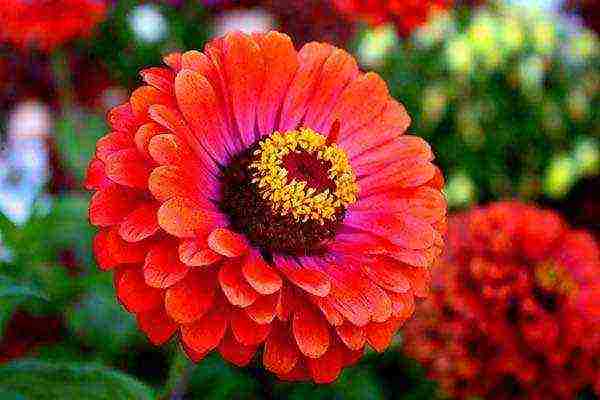 A flower belonging to the Astrov family has a straight, somewhat branched stem, on which oval-shaped leaves are planted without petioles. All of them have a somewhat pointed tip. Both the leaf and the stem of the plant are not smooth, on the contrary, their surface is covered with small, but rather stiff hairs.
A flower belonging to the Astrov family has a straight, somewhat branched stem, on which oval-shaped leaves are planted without petioles. All of them have a somewhat pointed tip. Both the leaf and the stem of the plant are not smooth, on the contrary, their surface is covered with small, but rather stiff hairs.
Inflorescences are simple or double petals, collected in a basket. The size of the inflorescences is different: the smallest ones have a diameter of about 5 cm, the large ones reach up to 15 cm.
The plant loves warmth, open sunny places, does not require special care and is not capricious. It is distinguished by its ability to grow rapidly and bloom for a long time. The flowers look like dahlias, marigolds and chrysanthemums.
Zinnia varieties
Of the 22 species of this annual known in nature, only four are used in ornamental gardening: graceful, narrow-leaved, fine-flowered, linearis. Having examined the varieties of zinnia with photos and names, you can independently choose the most suitable one for decorating your flower beds.
- Fine-flowered zinnia
these are low (up to 60 cm) bushes, consisting of brittle stems, adorned with small inflorescences (up to 3 cm).
- Linearis
the shortest zinnia flowers (25-35 cm). On miniature bushes, the same miniature inflorescences bloom, having a characteristic orange border on the petals.
But the graceful and narrow-leaved ones have become the most suitable for the climate of our country, we will present these description varieties in more detail.
- Graceful
varieties delight with their fast growth, large (up to 15 cm) sizes of inflorescences.
The most popular varieties of Zinnia graceful steel:
- Dahlia group, which includes varieties with well-branched bushes of different heights, long (up to 12 cm) leaves and large hemisphere-shaped inflorescences.
- The pom-pom group has another name - lilliputian.Low (up to 55 cm), rather compact, but at the same time shrubs of varieties of this variety producing many shoots usually bloom simultaneously with small (up to 4 cm) inflorescences and are distinguished by small leaves.
- The group of zinnias “Fantasy” or “Fantasy” is represented by medium-sized (up to 65 cm) varieties with large leaves and rather large (up to 10 cm), loose inflorescences.
- Narrow-leaved
varieties are characterized not only by oblong and somewhat elongated leaves with pointed tips. They have medium-sized inflorescences, the diameter of which is only 4-6 cm.
Zinnia varieties
Two popular varieties, graceful zinnia and narrow-leaved zinnia, come in many varieties and are capable of fulfilling the most demanding landscape designer's request.
Let's get acquainted in more detail with the flower and its varieties.
Stunted zinnia
Zinnia low-growing varieties belong to both elegant and narrow-leaved varieties. Florists love these varieties of miniature zinnia:
 “Little Red Riding Hood” (Rotcopchen) is a graceful pompom zinnia. The flower got its name due to its bright red color, the saturation of which even the summer sun cannot change. Low half-meter bushes (45-55 cm) take the form of a ball, decorated with dense densely double inflorescences, in some cases - rounded, in others - reminiscent of a truncated cone).
“Little Red Riding Hood” (Rotcopchen) is a graceful pompom zinnia. The flower got its name due to its bright red color, the saturation of which even the summer sun cannot change. Low half-meter bushes (45-55 cm) take the form of a ball, decorated with dense densely double inflorescences, in some cases - rounded, in others - reminiscent of a truncated cone).
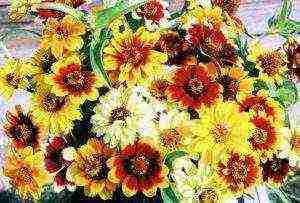 "Persian carpet" (Persian Carpet, Persian Carpet) - narrow-leaved zinnia, one of the most decorative varieties. The bushes are low, from 40 to 50 cm, when massively planted, they give the impression of a bright carpet, in which yellow, red, brown shades prevail. Inflorescences up to 6 cm in size are bicolor, ligulate flowers are distinguished by the presence of characteristic contrasting spots. The advantages of the variety include the ability to tolerate drought and frost resistance well.
"Persian carpet" (Persian Carpet, Persian Carpet) - narrow-leaved zinnia, one of the most decorative varieties. The bushes are low, from 40 to 50 cm, when massively planted, they give the impression of a bright carpet, in which yellow, red, brown shades prevail. Inflorescences up to 6 cm in size are bicolor, ligulate flowers are distinguished by the presence of characteristic contrasting spots. The advantages of the variety include the ability to tolerate drought and frost resistance well.
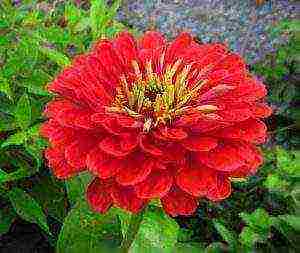 "Tom-Tamb" (Tom-Thumb) - another representative of graceful zinnia. Miniature bushes (35-45 cm) resembles "Little Red Riding Hood" with their bright red inflorescences that do not fade in the sun. However, compared to the globular or rounded inflorescences found in Rotcopchens, Tom-Thumb inflorescences appear flatter.
"Tom-Tamb" (Tom-Thumb) - another representative of graceful zinnia. Miniature bushes (35-45 cm) resembles "Little Red Riding Hood" with their bright red inflorescences that do not fade in the sun. However, compared to the globular or rounded inflorescences found in Rotcopchens, Tom-Thumb inflorescences appear flatter.
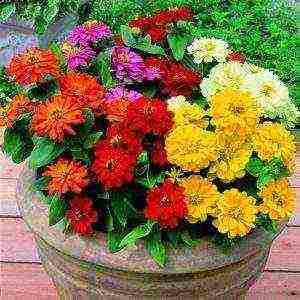 “Short Staf” is one of the lowest, even among low-growing varieties, whose height - up to 25 cm, is covered with rather large (up to 10 cm) multi-colored inflorescences (cherry and coral color, red and white).
“Short Staf” is one of the lowest, even among low-growing varieties, whose height - up to 25 cm, is covered with rather large (up to 10 cm) multi-colored inflorescences (cherry and coral color, red and white).
Bouquet zinnia
For flower growers, zinnia is a unique plant. It can be grown both in a flower bed and in a pot. The flower also shows itself well when cut, and can delight with its appearance for up to 14 days. The bouquet of zinnias is especially valuable because the flower is odorless and will not cause unpleasant sensations to people whose flower smell causes headaches.
In order to grow zinnia, the bouquet of which is pleasant to present, it is recommended to use a zinnia mixture of cut varieties.
 California Giants (Californiche Risen) is an ideal blend for cutting. Tall bushes (from 90 to 100 cm) are impressive with large (14-15 cm) inflorescences that have a very different color. Among the Giants - flowers are white, yellow, creamy and lilac, red and different shades of this color - orange and purple, pink and salmon. Flowers can retain their spectacular appearance in a vase for up to 10-12 days.
California Giants (Californiche Risen) is an ideal blend for cutting. Tall bushes (from 90 to 100 cm) are impressive with large (14-15 cm) inflorescences that have a very different color. Among the Giants - flowers are white, yellow, creamy and lilac, red and different shades of this color - orange and purple, pink and salmon. Flowers can retain their spectacular appearance in a vase for up to 10-12 days.
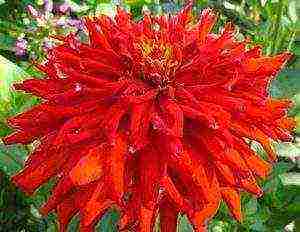 Cactus zinnia - due to its high growth up to 90 cm, it is excellent for cutting. Straight stems, large flowers, petals of unusual shape. Prolonged flowering - from June to September, stands for a long time cut in water.
Cactus zinnia - due to its high growth up to 90 cm, it is excellent for cutting. Straight stems, large flowers, petals of unusual shape. Prolonged flowering - from June to September, stands for a long time cut in water.
Landscape Design Tips
An attractive flower in the design of the site for many specialists occupies one of the main places.
Read DIY Zinnia Growing
Professionals suggest following some guidelines that will allow zinnias to look their best on your site.
- It is preferable to use the plant for group plantings, although it looks beautiful with a single planting.
- For a mixborder, tall varieties are most suitable; for borders, use a low-growing zinnia.
- If you like a design that embodies a rustic style, use zinnia in combinations with the following colors: aster, marigolds, calendula, bell, chamomile, chrysanthemum.
- Use zinnia for single plantings in the garden, in the garden with vegetables, table herbs. A bright spot will be expressive against a green background, and in addition, it will become an additional source of attracting insects for pollination.
- Linear plantings of zinnias look good, which are a kind of separators of vegetable beds or are planted along garden buildings, garden paths.
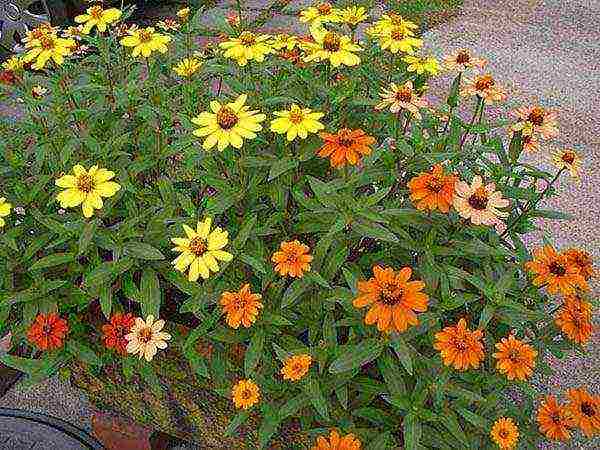
Zinnia angustifolia

Zinnia undersized

Zinnia Fantasy
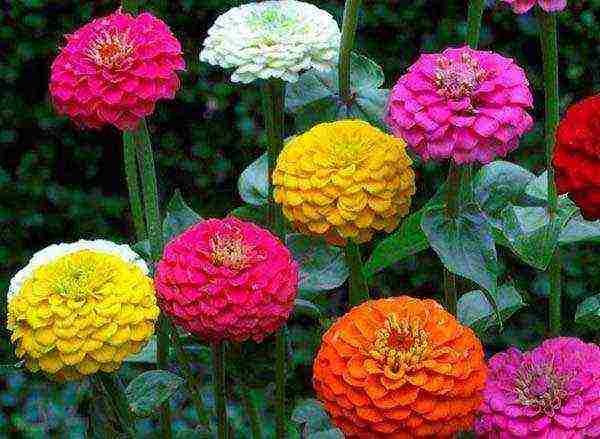
Zinnia pomponnaya
Experienced flower growers know: zinnia responds to care and maintenance with beauty until the very frost.
Do you want your flower garden to please the eye not only during the summer, but also until the frost? This means that zinnia should definitely settle in your flower beds! A bright and multi-colored beauty will delight you with a variety of colors, literally transforming the site. You yourself can imagine this by getting acquainted with the zinnia varieties with photos and names.
Zinnia flower through the eyes of a botanist
The name of the German physician and botanist Johann Zinn, who in the distant 18th century was the first to bring seeds of a flower unknown to Europeans, was forever fixed in the name of the flower. From that moment on, it became firmly rooted in European flower gardens.
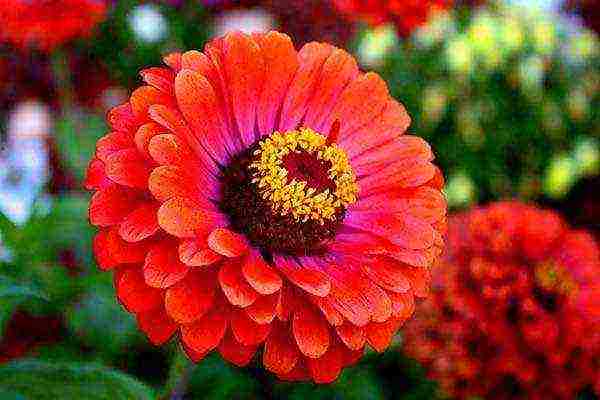 A flower belonging to the Astrov family has a straight, somewhat branched stem, on which oval-shaped leaves are planted without petioles. They all have a somewhat pointed tip. Both the leaf and the stem of the plant are not smooth, on the contrary, their surface is covered with small, but rather stiff hairs.
A flower belonging to the Astrov family has a straight, somewhat branched stem, on which oval-shaped leaves are planted without petioles. They all have a somewhat pointed tip. Both the leaf and the stem of the plant are not smooth, on the contrary, their surface is covered with small, but rather stiff hairs.
Inflorescences are simple or double petals, collected in a basket. The size of the inflorescences is different: the smallest ones have a diameter of about 5 cm, the large ones reach up to 15 cm.
The plant loves warmth, open sunny places, does not require special care and is not capricious. It is distinguished by its ability to grow rapidly and bloom for a long time. The flowers outwardly resemble dahlias, marigolds and chrysanthemums.
Zinnia varieties
Of the 22 species of this annual known in nature, only four are used in ornamental gardening: graceful, narrow-leaved, fine-flowered, linearis. Having examined the varieties of zinnia with photos and names, you can independently choose the most suitable one for decorating your flower beds.
- Fine-flowered zinnia
these are low (up to 60 cm) bushes, consisting of brittle stems, adorned with small inflorescences (up to 3 cm).
- Linearis
the shortest zinnia flowers (25-35 cm). On miniature bushes, the same miniature inflorescences bloom, having a characteristic orange border on the petals.
But the graceful and narrow-leaved ones have become the most suitable for the climate of our country, we will present these description varieties in more detail.
- Graceful
varieties delight with their rapid growth, large (up to 15 cm) sizes of inflorescences.
The most popular varieties of Zinnia graceful steel:
- Dahlia group, which includes varieties with well-branched bushes of different heights, long (up to 12 cm) leaves and large hemisphere-shaped inflorescences.
- The pom-pom group has another name - lilliputian. Low (up to 55 cm), rather compact, but at the same time shrubs of varieties of this variety producing many shoots usually bloom simultaneously with small (up to 4 cm) inflorescences and are distinguished by small leaves.
- The group of zinnias “Fantasy” or “Fantasy” is represented by medium-sized (up to 65 cm) varieties with large leaves and rather large (up to 10 cm), loose inflorescences.
- Narrow-leaved
varieties are characterized not only by oblong and somewhat elongated leaves with pointed tips. They have medium-sized inflorescences, the diameter of which is only 4-6 cm.
Zinnia varieties
Two popular varieties, graceful zinnia and narrow-leaved zinnia, come in many varieties and are capable of fulfilling the most demanding landscape designer's request.
Let's take a closer look at the flower and its varieties.
Stunted zinnia
Zinnia low-growing varieties belong to both the elegant and narrow-leaved varieties. Florists love these varieties of miniature zinnia:
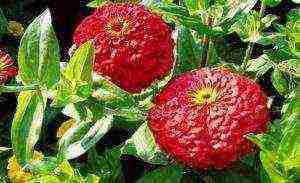 "Little Red Riding Hood" (Rotcopchen) - graceful pompom zinnia. The flower got its name due to its bright red color, the saturation of which even the summer sun cannot change. Low half-meter bushes (45-55 cm) take the form of a ball, decorated with dense densely double inflorescences, in some cases - rounded, in others - reminiscent of a truncated cone).
"Little Red Riding Hood" (Rotcopchen) - graceful pompom zinnia. The flower got its name due to its bright red color, the saturation of which even the summer sun cannot change. Low half-meter bushes (45-55 cm) take the form of a ball, decorated with dense densely double inflorescences, in some cases - rounded, in others - reminiscent of a truncated cone).
 "Persian carpet" (Persian Carpet, Persian Carpet) - narrow-leaved zinnia, one of the most decorative varieties. The bushes are low, from 40 to 50 cm, when massively planted, they give the impression of a bright carpet, in which yellow, red, brown shades prevail. Inflorescences up to 6 cm in size are bicolor, ligulate flowers are distinguished by the presence of characteristic contrasting spots. The advantages of the variety include the ability to tolerate drought and frost resistance well.
"Persian carpet" (Persian Carpet, Persian Carpet) - narrow-leaved zinnia, one of the most decorative varieties. The bushes are low, from 40 to 50 cm, when massively planted, they give the impression of a bright carpet, in which yellow, red, brown shades prevail. Inflorescences up to 6 cm in size are bicolor, ligulate flowers are distinguished by the presence of characteristic contrasting spots. The advantages of the variety include the ability to tolerate drought and frost resistance well.
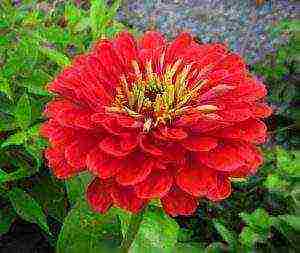 "Tom-Tamb" (Tom-Thumb) - another representative of graceful zinnia. Miniature bushes (35-45 cm) resembles "Little Red Riding Hood" with their bright red inflorescences that do not fade in the sun. However, compared to the globular or rounded inflorescences typical of Rotcopchens, Tom-Thumb inflorescences appear flatter.
"Tom-Tamb" (Tom-Thumb) - another representative of graceful zinnia. Miniature bushes (35-45 cm) resembles "Little Red Riding Hood" with their bright red inflorescences that do not fade in the sun. However, compared to the globular or rounded inflorescences typical of Rotcopchens, Tom-Thumb inflorescences appear flatter.
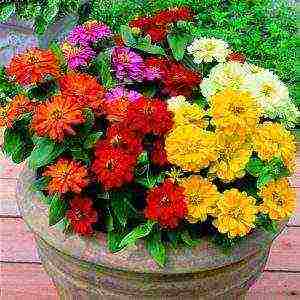 “Short Staf” is one of the lowest, even among low-growing varieties, whose height - up to 25 cm, is covered with rather large (up to 10 cm) multi-colored inflorescences (cherry and coral color, red and white).
“Short Staf” is one of the lowest, even among low-growing varieties, whose height - up to 25 cm, is covered with rather large (up to 10 cm) multi-colored inflorescences (cherry and coral color, red and white).
Bouquet zinnia
For flower growers, zinnia is a unique plant. It can be grown both in a flower bed and in a pot. The flower also shows itself well when cut, and can delight with its appearance for up to 14 days. The bouquet of zinnias is especially valuable because the flower is odorless and will not give unpleasant sensations to people whose flower smell causes headaches.
In order to grow zinnia, the bouquet of which is pleasant to present, it is recommended to use a zinnia mixture of cut varieties.
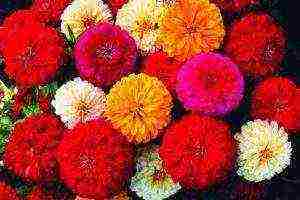 California Giants (Californiche Risen) is an ideal blend for cutting. Tall bushes (from 90 to 100 cm) are impressive with large (14-15 cm) inflorescences that have a very different color. Among the Giants - flowers are white, yellow, creamy and lilac, red and different shades of this color - orange and purple, pink and salmon. Flowers can retain their spectacular appearance in a vase for up to 10-12 days.
California Giants (Californiche Risen) is an ideal blend for cutting. Tall bushes (from 90 to 100 cm) are impressive with large (14-15 cm) inflorescences that have a very different color. Among the Giants - flowers are white, yellow, creamy and lilac, red and different shades of this color - orange and purple, pink and salmon. Flowers can retain their spectacular appearance in a vase for up to 10-12 days.
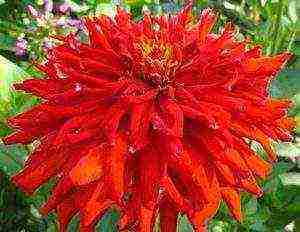 Cactus zinnia - due to its high growth up to 90 cm, it is excellent for cutting. Straight stems, large flowers, petals of unusual shape. Prolonged flowering - from June to September, stands for a long time cut in water.
Cactus zinnia - due to its high growth up to 90 cm, it is excellent for cutting. Straight stems, large flowers, petals of unusual shape. Prolonged flowering - from June to September, stands for a long time cut in water.
Landscape Design Tips
An attractive flower in the design of the site for many specialists occupies one of the main places.
Read Do-it-yourself Zinnia Growing
Professionals suggest following some guidelines that will allow zinnias to look their best on your site.
- It is preferable to use the plant for group plantings, although even with a single planting, zinnia looks beautiful.
- For a mixborder, tall varieties are most suitable; for borders, use a low-growing zinnia.
- If you like a design that embodies a rustic style, use zinnia in combinations with the following colors: aster, marigolds, calendula, bell, chamomile, chrysanthemum.
- Use zinnia for single plantings in the garden, in the garden with vegetables, table herbs. A bright spot will be expressive against a green background, and in addition, it will become an additional source of attracting insects for pollination.
- Linear plantings of zinnias look good, which are a kind of separators of vegetable beds or are planted along garden buildings, garden paths.
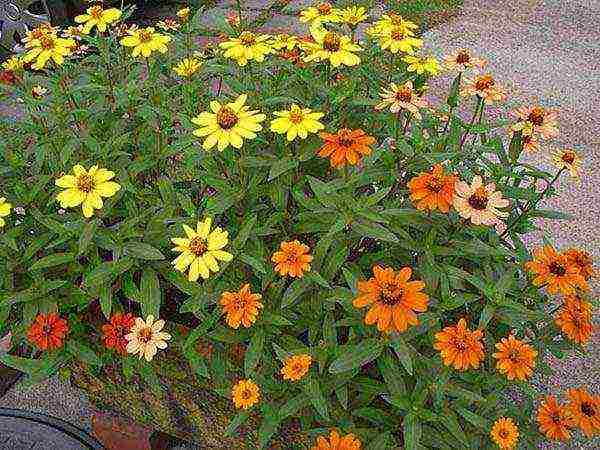
Zinnia angustifolia
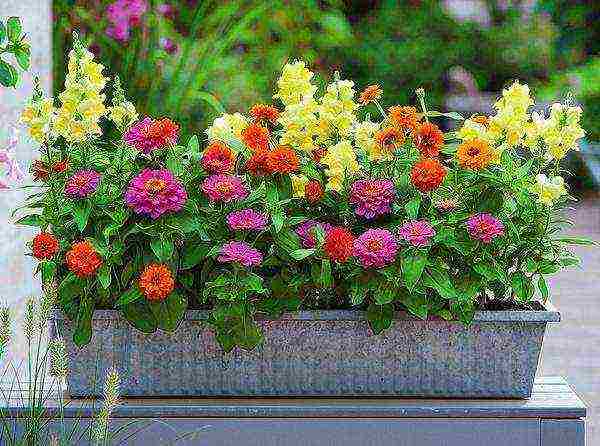
Zinnia undersized
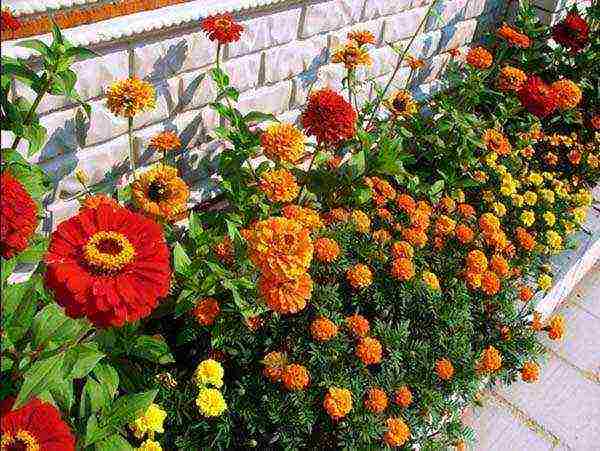
Zinnia Fantasy
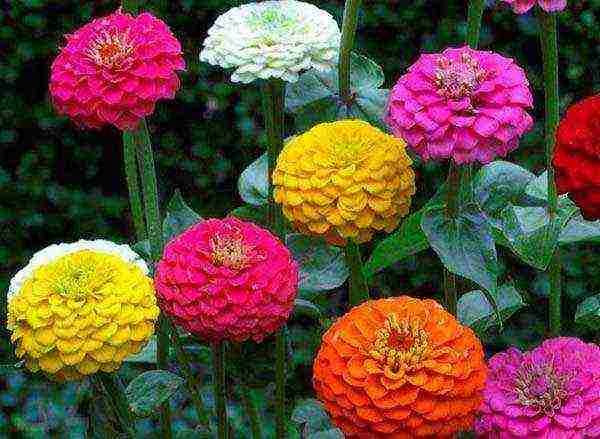
Zinnia pomponnaya
Experienced flower growers know: zinnia responds to care and maintenance with beauty until the very frost.
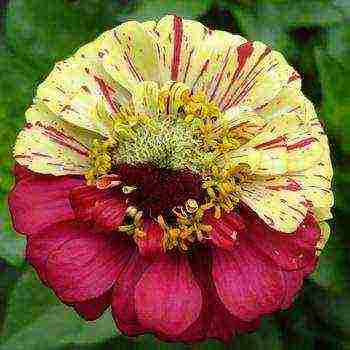 Looking at dahlia zinnia, it is sometimes difficult to distinguish this flower from a dahlia.But the graceful zinnia "Lilliput" looks completely different - these plants cannot be confused with others. Currently, a new type of zinnia "Fantasy" has been developed, the description of which differs sharply from all the others. Details about all these forms, as well as about planting and caring for zinnia - in this material.
Looking at dahlia zinnia, it is sometimes difficult to distinguish this flower from a dahlia.But the graceful zinnia "Lilliput" looks completely different - these plants cannot be confused with others. Currently, a new type of zinnia "Fantasy" has been developed, the description of which differs sharply from all the others. Details about all these forms, as well as about planting and caring for zinnia - in this material.
Description of zinnia with pictures
This annual widespread floral plant is popularly called "paniches". The zinnia flower belongs to the Asteraceae family and has about 20 species.
By height, zinnias are divided into high (70-90 cm), medium (40-50 cm) and low (up to 30 cm), wide-spreading or more compact. The shoots of the first order significantly outgrow the main one, so that later after flowering it becomes almost invisible. All shoots end in a basket-shaped inflorescence. Some groups of zinnias produce a large number of flowering shoots of the second and third orders, while others have fewer.
Pay attention to the photo - zinnia has inflorescences-baskets, large in most varieties and small double and semi-double:

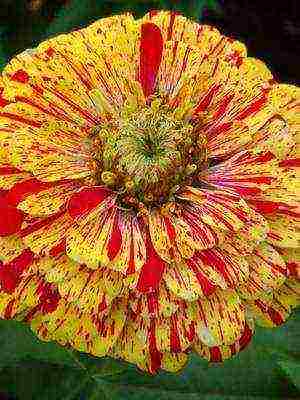
Flowers are always brightly colored - white, pink, yellow, lilac, orange, red, purple.
Flowers in the inflorescence are tubular and ligulate. Tubular flowers consist of 5 fused petals. Zinnia seeds from the peripheral rows have a triangular shape, their length is up to 1 cm, the width at the base is 0.5 cm. The seeds from the middle rows have the shape of an elongated narrow triangular spear, and the seeds from the central part of the inflorescence are flat, thyroid.
How to plant zinnia and growing a plant from seeds (with photo)
Before planting zinnia, keep in mind that it is a heat-loving and light-loving plant. It blooms profusely from June until frost. The culture is undemanding to the soil, but it develops especially well on deep nutrient soils, filled with organic fertilizers.
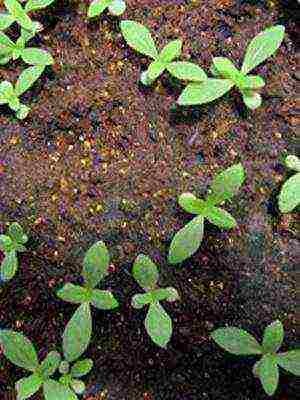
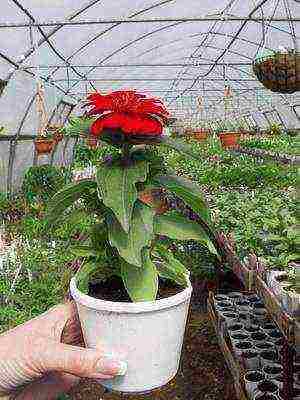
When growing zinnia from seed, choose a sunny, open location for the plant. Plants are resistant to high temperatures and low humidity of soil and air. But with prolonged drought, the decorativeness of plants decreases. When caring for zinnia, abundant watering is required, otherwise the flowers become smaller, the color becomes less bright, and the leaves lose their turgor. The plant does not tolerate even the slightest frost. The flowers are cross-pollinated, but self-pollination is also possible.
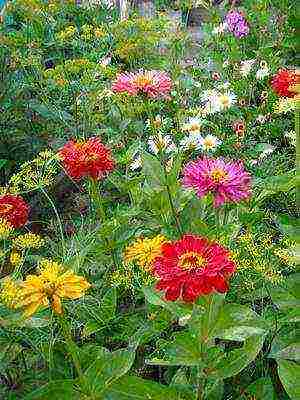

Zinnia is a fast growing plant. In the south, two months pass from sowing to flowering, in the central zone of Russia - two and a half.
The inflorescence blooms gradually from the periphery to the center and blooms for about a month. In the bright sun and, especially with strong dry winds, flowering ends faster, the color of the flowers fades somewhat. Faded inflorescences on first-order shoots give the plant a sloppy look, but if they are removed in a timely manner, decorativeness remains throughout the entire flowering period. Seeds are tied in large numbers two months after the beginning of flowering, ripen and stay on the shoots for a long time, which makes them easier to harvest.
In rainy years and in areas with a humid climate, seed ripening is delayed, and in the case of cold and rainy autumn, the baskets rot.
Long-term practice has shown that the largest number (80-95%) of plants with double inflorescences give seeds from the marginal and middle rows. Seeds from the central part of the inflorescence from tubular flowers give less double plants (40-50%).
After planting zinnias, seedlings appear in 4-6 days. From one plant, depending on the variety and degree of doubleness, from 7 to 15 g of seeds are obtained. In 1 g 120 - 150 seeds. Seeds remain viable for up to 3 years.
To increase the yield of mature seeds and improve their quality, no more than ten inflorescences should be left on the bush and the side shoots of the second order should be pinned.
Below are photos of growing zinnia from seeds at their summer cottage:
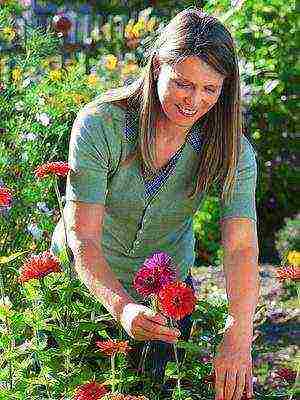
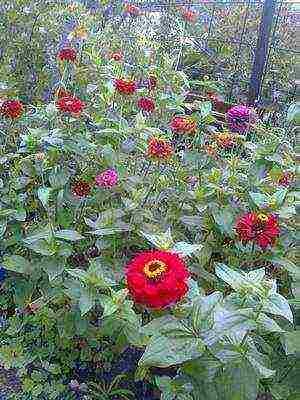
Zinnia groups with a photo: dahlia-flowered, graceful "Lilliput" and "Fantasy"
Currently, there are many varieties of zinnia belonging to different groups:
Dahlia (dahlia-flowered) zinnias are characterized by a sprawling or compact (60-70 cm) tall, powerful bush with a small number of first-order shoots. Inflorescences are large (10-12 cm in diameter), mostly terry.
As you can see in the photo, in dahlia-flowering zinnia, the largest inflorescences develop on the main shoot:
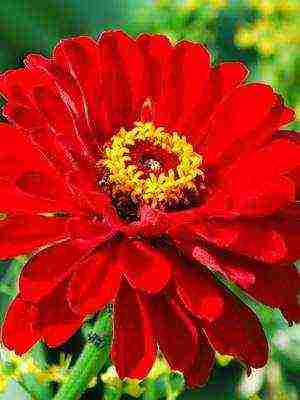
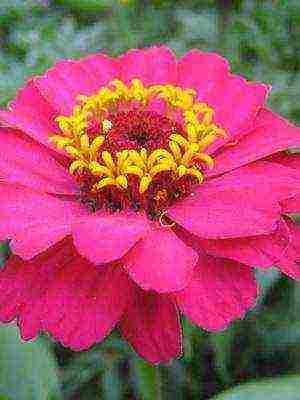
With an increase in the order of the shoots, the inflorescences become smaller and the doubleness decreases.
Within this group, varieties differ mainly in the color of the inflorescences.
Graceful zinnias "Lilliput" have low, compact, densely flowering bushes, with a small number of flowering shoots of the third or fourth orders.
Look at the photo of graceful zinnia - its leaves are smaller than those of varieties of other groups:
Inflorescences are also smaller (3-6 cm in diameter). They are dense, mostly terry. At the same time, a large number of inflorescences bloom on the bush.
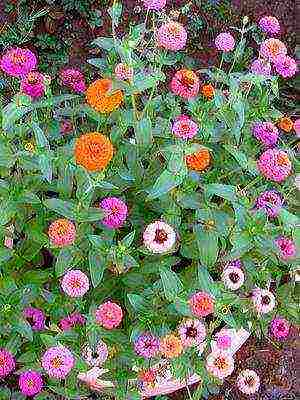

"Fantasy" - this is a new group, characterized by a special structure of inflorescences. The flowers are rolled into a tube and curved to the side, which gives them a curly look. Inflorescences on the main shoot up to 10 cm in diameter, on the lateral shoots almost two times smaller, hemispherical, double.
The best varieties and hybrids of zinnia
A wide variety of varieties of zinnia, differing in different shapes and colors of flowers, height and shape of the bush, long flowering, has made this crop a favorite plant in the garden of gardeners. High grades are used for cutting and individual spots on the lawn; medium-sized ones are grown in flower beds, they are used to decorate balconies, loggias; low - good for curbs, windows and potting. Zinnia is also valued for the fact that it tolerates dry and hot climates well and blooms for a long time.
Check out the photos and descriptions of the best modern varieties and hybrids of zinnias:
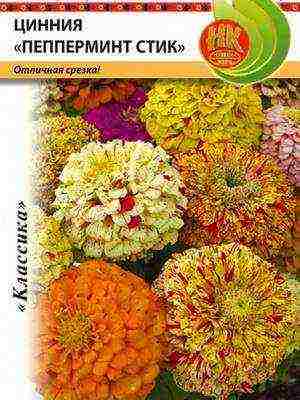
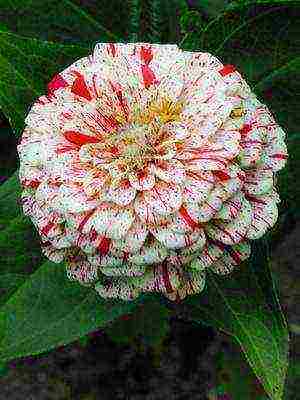
"Peppermint stick" - the elegant zinnia looks incredibly attractive. Spectacular double, large, bright inflorescences remain in the bouquet for a long time. A powerful plant with strong peduncles does not need a garter. It is used in curbs, in flower beds, as a cut plant.
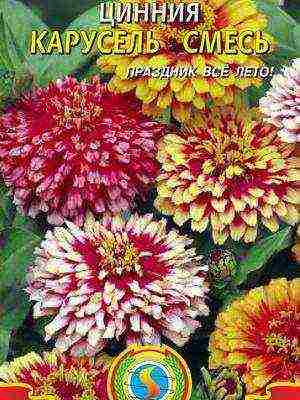

"Carousel" - a variety with multi-colored petals (red with yellow, red and white) of an extraordinary and festive color.
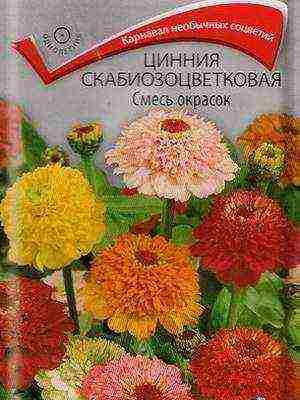
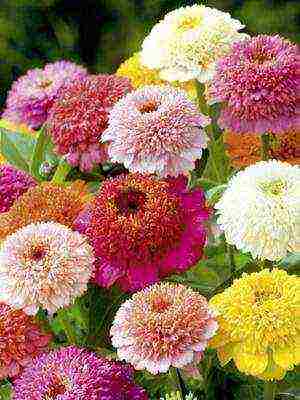
"Scabiozoflower" - a variety with high strong stems topped with original inflorescences (with an expanded center) of various colors.
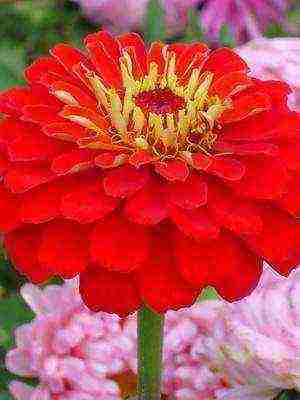

"Graceful" - the variety in the form of inflorescences belongs to the group of dahlia. Vigorous plants branch from the base. Hemispherical double inflorescences of various colors, 9-10 cm in diameter. Ligulate flowers are spoon-shaped concave, located in the inflorescence tiled.
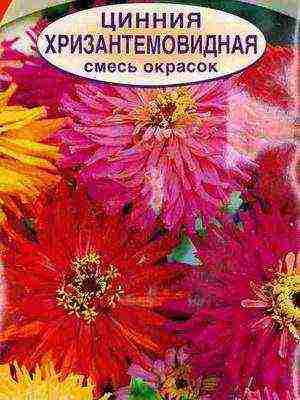
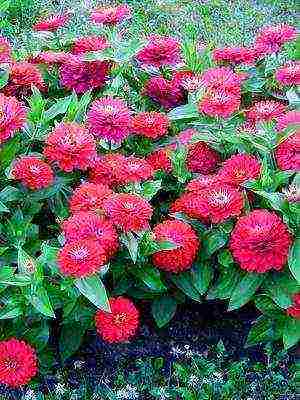
"Chrysanthemum" - a mixture of multi-colored colors. Fast growing plants with erect stems. Terry inflorescences-baskets, outwardly resembling chrysanthemum inflorescences. Ligulate flowers are oblong-lobed, slightly curved and curved in different directions.
Pay attention to the pictures of zinnias presented on this page - the flowers amaze the imagination with a riot of colors:
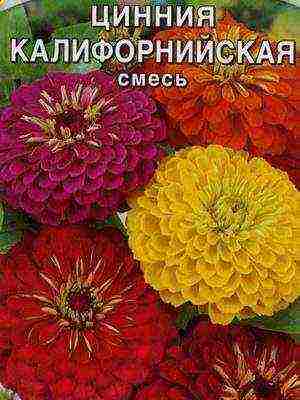
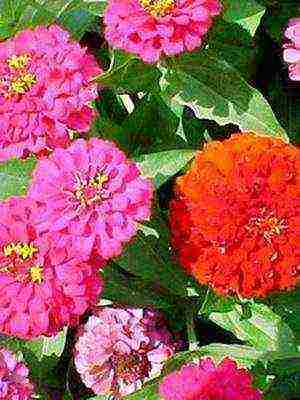
"California" - a mixture of colors, plants up to 90 cm high. Inflorescences are large, up to 14 cm in diameter, of various colors. It blooms profusely and for a long time. It goes well with marigolds, marigolds, vervain.
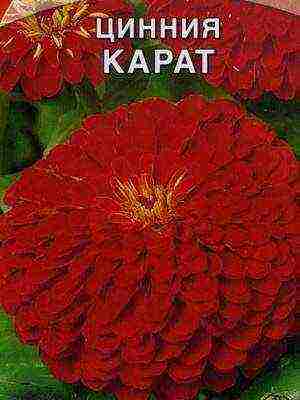

"Carat" - large-flowered variety, inflorescence size - 14-16 cm, plants up to 90 cm high. It is planted in variegated flower beds, flower beds, rabatki and for cutting. Cut flowers sit in the water for a long time.
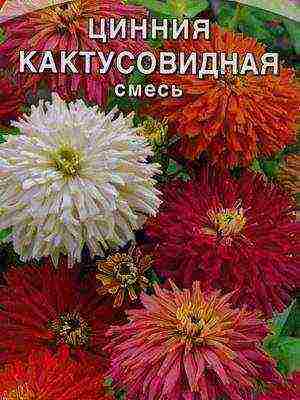

"Cactus" - a mixture of colors, incredibly attractive new look of this elegant zinnia with erect stems. Spectacular, densely double inflorescences with narrow long petals rolled into a tube give the whole plant a very decorative look.


"Lilliputian" - a mixture of colors, height up to 30 cm. Inflorescences are large - up to 14 cm in diameter. It blooms profusely and for a long time. It goes well with marigolds, marigolds, vervain.
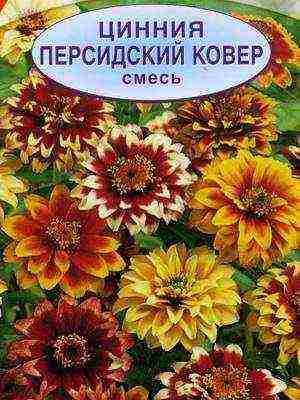
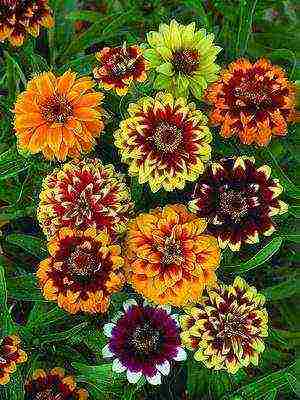
"Persian rug" - narrow-leaved zinnia, low, strongly branched bushes completely covered with subulate medium-sized star-shaped inflorescences-baskets. Plant height 30-40 cm, size of inflorescences 4-6 cm.
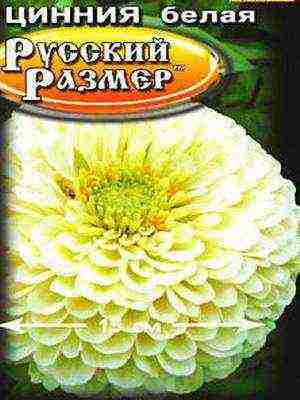
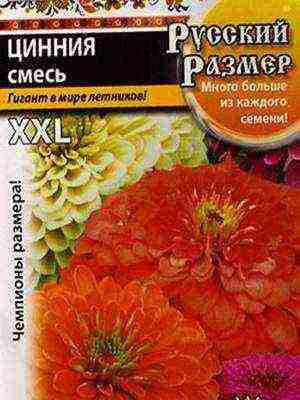
"Russian size" F1 scarlet and gold. The majestic giant in the world of annuals! When grown in a greenhouse, the plant reaches the height of an adult. Each terry inflorescence up to 12 cm in diameter retains its decorative effect for almost three weeks. Effective cutting for large vases and compositions. Blooms continuously until frost. Plant height 160cm.
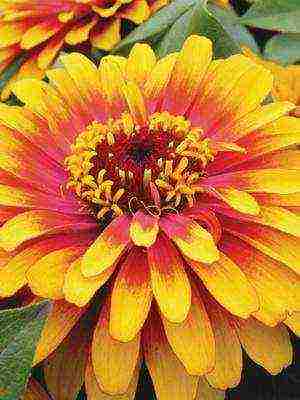
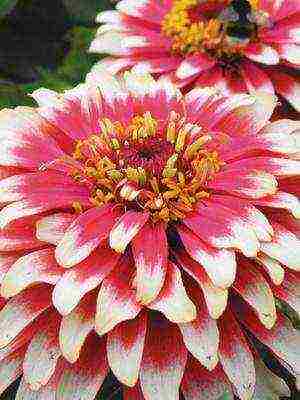
Sizle Swizzle Cherry Ivory F1. An unusual, eye-catching color scheme makes this zinnia a real star in the flower bed! All season she proudly flaunts her magnificent outfit, regardless of the weather conditions.

Composition with her participation: a flower garden, a pots or a balcony box is always decorative. Despite its compactness, it gives an excellent high quality cut.
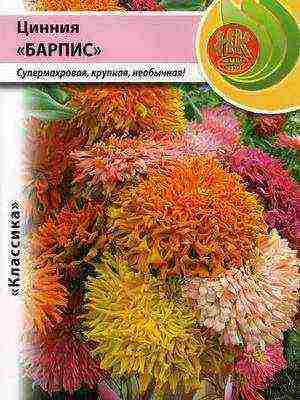

"Barpeis", mixture. A new variety with a unique flower shape. Magnificent, super-double inflorescences of all kinds of bright colors reach 13 cm in diameter. An incredibly colorful variety, blooms for a long time and stands perfectly in cut.
Types and varieties of zinnia
Similar articles
About a month after planting, but long before the flowering itself, the first feeding of the culture is done. Urea and any of the organic fertilizers are diluted in water (for 10 liters - one tablespoon of urea + fertilizer).Growing a plant is quite simple, as when planting and caring for a hosta, although little whims are inherent in the flower. Zinnia reproduces only by seeds that are afraid of frost and die already at a temperature of -1̊ C. Therefore, sow seeds in open ground, making sure that frosts will not return.New Burpee's Hybrids - very large inflorescences (diameter 13-15 cm) yellow, red, pink, carmine, salmon. Plant height up to 70 cm. Likes: Zinnia planting and careZinnias, a mixture of varietiesThe minimum of worries is the maximum return. The unpretentious zinnias will delight your eyes without having to take care of them with all your might.Numerous hybrid varieties have been produced. Specifically the Desert Sun Mixed seriesDahlia,In decorative floriculture, varieties of graceful zinnia are most often used. This is the most famous species, especially popular for cutting. Strong hollow stems, large leaves and semi-double inflorescences (in some varieties up to 12 cm in diameter) with dense shiny "petals" - everything is very solid and not at all like that really graceful zinnia with small inflorescences that appeared in Europe at the end of the 18th century When budding, a second feeding is carried out When growing zinnia, there are a couple of important rules. It is required to remove decaying and faded inflorescences, especially in wet weather, and treat the plant with fungicides at the end of August.Scabioza (anemone) - plants about 60 cm high, inflorescences-baskets of various colors.Major. Zinnia. Zinnia.for which you will carry out, we have described using the example of the following According to the structure of the inflorescences, the shape of the reed flowers and the height of the zinnias, they are divided into several groups: dahlia, chrysanthemum, scabioza, gaiardio, pompom, fantasy.A feast for birds and butterflies. Plant some zinnias and watch your garden come to life with a host of winged creatures.Profusion Mixed is available in all shades of yellow and orange. The balls of sunny inflorescences do not create a feeling of massiveness, therefore, the variety is quite suitable for a mixed border of summer houses, as well as for a "fence" or for a flower bed. It is better to look at them from some distance or from above, for example, from a balcony. Bright and joyful, they are able to cheer up even on a gloomy day.
There are 4 types of zinnias in modern catalogs:
- ... For 10 liters of water, you will need 1 tablespoon of liquid fertilizer, which can be purchased at any flower shop.
- Since perennial zinnia is too capricious plant when planting and leaving, then summer residents are most popular about
- The new Attraction - in the center of the basket - is a "pillow" of overgrown tubular flowers, surrounded by one row of wide reed flowers in the form of a cuff. This inflorescence is called anemone, or scabiose. Plants about 60 cm high, baskets of various colors.
Most of the zinnia species came to Europe from Mexico, where they were cultivated even before 1520. In Europe, zinnia appeared only in 1750, where it was nicknamed - "the flower of the poor." Zinnia easily multiplied, its cultivation did not cause any difficulties for Europeans, and therefore the flower was available to everyone.Zinnia species In Russia, the most common varieties of dahlia and pompom zinnias, less often they use varieties of the fantasy group.
Endless flowering. The more flowers you pinch off the zinnia, the more flowers will form.
- bushes 30-35 cm high, covered with small multi-colored "daisies". Among the new varieties we will nameAnother well-known species, suitable exclusively for flower beds, isScabiosa,
- Graceful
- After opening the buds, they can be sprayed with the "Bud" preparation (for 10 liters of water - 10 g). Then feeding is carried out at your request, there is no urgent need for them. It is important not to go far in fertilizers with nitrogen (due to its large amount, the stems can rot).
- Annual species: narrow-leaved and graceful
- Fantasia (Fantasia) - almost spherical bushes, 50-65 cm tall, compact. ... The inflorescences are terry, loose, 8-10 cm in diameter, the ligulate flowers are narrow, sometimes bifurcated at the ends, twisted or curved, so the baskets seem shaggy. In this group, there is only one variety-population, but its representatives have a variety of colors. Flowering inflorescences 16-22. Blooms from mid-June until frost.
- Cynia was once called "youth and old age" for its ability to produce new flowers, while the old ones have not yet faded. In Russia, for its gallant appearance and dapperness, zinnia received the name "major", in Kazakhstan - "major", in Ukraine it is called "major".
- ... They go well with any flower planting scheme.
- Most often, seeds are sold in a mixture, although recently, with the development of the culture of landscape gardening, the need for seeds, divided by varieties or colors, has increased.
Zinnia
Swizzle Scarlet and Yellow Zinnia Hage
Gaiyardiotsvetnye, (Many gardeners recommend sprinkling the soil with wood ash before feeding.. They became the basis for breeders when breeding many varieties of zinnia. Recently, new wonderful varieties and hybrids have appeared: Often called zinnia “Grandmother's flower.” These beautiful and unpretentious plants were grown by our grandmothers. The fashion for flowers is returning, and zinnia is again becoming in demand. Now in almost every garden you can see this bright annual. Elegant, attractive zinnia adorns the flower garden with spectacular multi-colored all summer and half of autumn With little to no return, zinnia delights the eye with splendor until mid-October Zinnias are especially popular in the US Most modern varieties were bred there. - Bushes are powerful, spreading or compact, 60-90 cm tall, with a small number of first-order shoots. The leaves are large, up to 12 cm long. Inflorescences are hemispherical, large, 10-14 cm in diameter, terry. The ligulate flowers are elongated-lobed, arranged in tiles with slightly raised edges. (
And (
Pompom (lilliputian), Zinnia elegans If you fulfill all these simple requirements for planting and caring for zinnia flowers, then, rest assured, a wonderful plant will thank you in full.
Photo of a narrow-leaved variety of the Colossus flower - a very majestic zinnia, growth (100-125 cm).Plants are powerful, branchy from the base, do not need a garter. Huge double inflorescences 10-13 cm in diameter flaunt on long, strong stems. Blooms from June until frost. It is better to place in the garden in separate groups, since this plant overshadows less spectacular plants with its richness and richness of colors. Ideal in vases Zinnia belongs to the Asteraceae family. The name of the plants was given by Karl Linnaeus in 1759 in honor of Johann Gottfried Zinn (1727-1759), professor of pharmacology, director of the botanical garden in Göttingen, who provided Linnaeus with herbarium material for his work. zinnia should be planted after spring frosts. Planting zinnia seeds is carried out in the middle - end of April, they germinate quickly in 5-7 days, after the emergence of shoots, the sprouts are placed closer to the sun. Sprouted flowers should be watered regularly when the topsoil dries out. Dive should be carried out at the moment of full development of the first true leaf. The roots should be shortened deeper by 1/3, in which case they will branch better. Cotyledon leaves should not be covered with soil.
Zinnia graceful, grade 'Envy'
Swizzle Cherry and Ivory Z. haageana cactaceae,), well-groomed perennials
All varieties of crops are divided intoCarousel is a very elegant variety with red "petals" with cream or yellow tips (height up to 60cm). Low zinnias, especially F1 hybrids, more than tall ones with large baskets, are suitable for flower beds. We give a description of some varieties that are already cultivated in the conditions of central Russia.This is a fast-growing annual herb, cross-pollinated plant, forms an erect, spreading or compact bush, 15 to 110 cm high (sometimes even higher). 10 days after the pick, you need to fertilize with complex mineral fertilizers. Some varieties of dahlia zinnia ) Is a genus of annual and perennial grasses and shrubs of the Astrovye family (which we meet under the name “
). The most famous variety seriesFantasy.Narrow-leaved sowed seedlings, then on a flower bed, they grew up beautifully, huge, bright, beautiful. Their shallow root system became a problem. When the torrential rains started, the bushes became heavy and began to collapse with upturned roots. I think it was necessary to remove some of the stepsons, like a tomato, so that the bushes grow more compact. I had to prop it up. The seeds did not match up a bit with what had grown. On the package, dwarfs were promised, and whole generals grew up (I remembered that sometimes zinnias are called majors). But in general, I was satisfied and this year I bought new varieties.:
Magellan (Magelan). Plants 25-35 cm high with densely double dahlia inflorescences (diameter 9-10 cm) of various colors (cherry, coral, creamy white, orange, pink, red, salmon and yellow).Stems are powerful and strong, covered with hard hairs. Strong stalks of zinnia do not need a garter, and cut flowers stand in water for 7-10 days. Leaves are oblong-oval, sessile, opposite or whorled on the stem.Seedlings of zinnia Violet (Violett) - Sprawling bush, 60-75 cm tall. The inflorescences are terry, dense, 9-12 cm in diameter, purple, of various shades. Flowering inflorescences 18-23. Zinnia 'Violet' blooms from mid-June until frost.CarouselPersian Carpet Mixed In Russia, the most common varieties of dahlias and pompoms, less often plants of the fantasy group are used. (Zinnia flower (zinnia) is a plant of the Asteraceae family that grows in Central America, Mexico. This is mainly a flower bed plant, but to grow zinnia can be successfully done at home.Zinnia is very thermophilic, loves bright light and space around itself, so when growing, try to provide free space within a radius of half a meter around the flower pot. She also needs nutritious soil, which will make the inflorescences more lively and vibrant. Of particular importance is the variety of species and varieties of zinnias, which have different shapes, sizes and colors of inflorescences. You can find red, bright yellow, pink, orange zinnias. Also separately you can mention the existence of cactus, dahlia-like, mossy varieties of zinnia.high (from 60 to 95 cm), Peter Pan. Plants 30-35 cm high, densely double inflorescences about 10 cm in diameter, light and dark pink, bright red, raspberry, orange, orange-red, yellow, cream and pure white. you need a warm, sunny area in a place protected from the wind, responds well to watering.Not picky when transplanting, it quickly grasps the soil and normally grows. The land for it must be rich, before the plant blooms, it is necessary to apply mineral fertilizers 1-2 times.Crimson Monarch - Sprawling bush, 60-70 cm tall. The inflorescences are terry, dense, sometimes loose, large, 11-13 cm in diameter, dark red. Flowering inflorescences 18-25. Blooms from mid-June until frost.
).". These are plants 60 cm high with large double, bicolored inflorescences, the "petals" of which are tapering at the ends, like, With semi-double, bicolor inflorescences (red - with white, yellow, orange, lemon). This mixture is most often planted in large tracts, and it really resembles variegated oriental carpets.DahliaZ. angustifolia Zinnia growing and nursing medium (from 35 to 50 cm), Swizzle. Plants 25-30 cm high, double inflorescences 8-10 cm in diameter Desirable soil light, fertile, permeable, with a neutral reaction Zinnia photo Lavender Queen (LavenderKonigin) - Sprawling bush, 65-80 cm tall. Inflorescences are dense, double, 10-12 cm in diameter, lavender with a purple tint. Flowering inflorescences 19-23. Zinnia Lavender Queen blooms from mid-June until frost The genus of zinnia has 15-20 species native to Central and South America.For landscape flower beds, they usually choose
- powerful, sprawling or compact bushes 60-90 cm high. The flowers are ligulate, with a rounded edge, they find one on top of the other like a tile, the inflorescences are densely double. Cut zinnias retain their freshness and cost better than dahlias.
), Or
Optimal temperature: these flowers need warmth, therefore, keep the temperature in the room at a level of 24-26 0С. Lighting: for the successful development of the plant, bright lighting is necessary, give it a spacious, sunny place in the room. Air humidity: spray the flower once a week. Watering: medium abundance of watering is preferable, without creating over-watering. If growing your plant outdoors, watch for changes in air temperature and adjust watering accordingly. Fertilizers: Fertilize the plant with mineral fertilizers once or twice a month. Soil Composition: Use a turf soil with a small amount of leafy soil and peat. Bloom: bloom in summer and autumn. Lifespan: is an annual plant. Difficulty of development: it is quite simple to grow zinnia both in indoor and in garden conditions.
Low or dwarf (no more than 30 cm).
The series includes 2 two-color hybrids:
Zinnia flower
For zinnia, you should choose a bright place, and most importantly a warm one, provide protection from the wind. Zinnia blooms 2-2.5 months after the appearance of the first shoots, it can bloom before the first frost. Zinnia begins to turn black only at -1 degrees. The peculiarity of this flower is drought resistance.If the lack of moisture is long, the inflorescences become smaller, the decorative effect of plants deteriorates. Wet weather has a rather detrimental effect -
Zinnia cultivation
Orange King (Orange Konig) - Sprawling bush, 60-70 cm tall. Terry inflorescences, medium density, large, 12-14 cm in diameter, bright red-orange. Flowering inflorescences 18-23. Blooms from late June until frost.
Planting zinnia seeds
Zinnias are annual and perennial, herbaceous and semi-shrub plants. Leaves are ovate with a pointed apex, sessile, whole, opposite or whorled on the stem. Inflorescences are baskets, solitary, relatively large, apical, on long, usually from above, thickened peduncles or sessile. The wrapping of the baskets is multi-row, tiled. The marginal flowers are ligulate, variously colored: yellow, red, white, pink, purple, lilac, densely arranged, with a rounded or notched limb; internal - small, tubular. Zinnia fruit is achene.
Planting zinnia in open ground
Motley zinnia
Zinnia fine-flowered
There are varieties with a rare color of inflorescences: carmine - "
Hage
Zinnia reproduction and growth
Zinnia care
Tall zinnia, like heather, about the medicinal properties of which you read, is grown for cutting
- Cherry Ivory with cherry baskets and creamy petal tips,
- Zinnia blooms are extremely effective. The complex inflorescences of zinnia are large, up to 15 cm in diameter, consist of 2 types of flowers: the outer ligulate flowers are large, in shape they can be elongated-oval, linearly elongated or curled lengthwise into a tube, sometimes bifurcated at the end. Inner flowers are tubular, small and narrow. The lingual flowers of zinnia are female, tubular (located in the center of the inflorescence) are bisexual.
- Zinnia flowers
Polar Bear - she is Zinnia Polar Bear or, in another spelling. The bush is compact, 60-65 cm tall. Inflorescences are densely double, dense, 12-14 cm in diameter, white with a slight greenish tinge. Flowering inflorescences 17-20. Blooms from mid-June until frost.
Semi-double, orange zinnia
- (
- Crimson monarch
- (
- Zinnia seeds are the only way to reproduce. It is very easy to grow zinnia from seeds. To do this, at the beginning of April, the seeds are sown, depending on their number, either in oblong boxes or in ordinary pots. When they sprout, they need to be planted in separate pots or planted in a flower bed. Provide a distance of 30cm between the seedlings. You can plant several plants in a pot, preferably no more than 3. In the case of flower beds, planting zinnia should be carried out in early summer, when the air is already warm enough. For more information on reproduction, see Reproduction of plants (Sexual reproduction of plants> Reproduction by seeds).
- ... Flower lovers do not indulge this variety too much due to its bulkiness.
Scarlet Yellow (Scarlet Yellow) with red inflorescences and bright yellow tips and "petals".The color of flower baskets is unusually diverse: white, yellow, pink, orange, violet, lilac (there is no only blue) .begin to rot. In damp cold weather, the baskets often rot, so as not to reduce the decorativeness of the plant, you need to pinch off the faded baskets Purple Prinse - The height of the bush is up to 60 cm, with large purple inflorescences, blooms from late June until frost. gardening uses two annual species - Zinnia is a very long-flowering flower, while very bright and beautiful. This flower is very fond of various pollinating insects:
Z. tenuiflora
Description of zinnia
", Lilac -"
Z. haageana
Diseases and problem momentsBranching lush bushes of low-growing varieties of zinnia are versatile and decorate flower beds as a pot or container culture. In addition, they are resistant to the wind, and with good care they bloom continuously and richly.These zinnias are more suitable for containers and balconies.When grown outdoors, they need a sunny spot with light, drained soil.Zinnia blooms 55-65 days after sowing and continues to bloom until late autumn. Individual inflorescences have a lifespan of 34-35 days Seeds are tied in large numbers, but develop gradually, begins to ripen 60-65 days after flowering, so in our conditions it is very difficult to get ripe zinnia seeds. You can accelerate the development of seeds if you leave 1-2 inflorescences, removing all lateral shoots. AnyRose (Rosa) - Sprawling bush, 50-65 cm tall. The inflorescences are terry, medium-dense, large, 10-12 cm in diameter, pink in various shades. Flowering inflorescences 15-20. Blooms from mid-June until frost.Zinnia graceful Bumblebee on a zinnia flower) - bushes about 60 cm high with thin, geniculate, reddish stems. This plant has small (up to 3 cm in diameter) inflorescences, "petals" are narrow, bent outward, with twisted tips, dark red.
Growing and caring for zinnia
Dream
),
If the tips of the leaves of the plant begin to dry out, pay attention to the humidity of the air and soil; for a while, you can put the flower pot in a shaded place. Plant treatments are described in the sections: Plant Pests and Plant Diseases.
The low grade is also cut - from them unique colorful compositions are made
Short Staff. Plants with a height of 20-25 cm are the most compact and lowest zinnias for open ground. Terry baskets (diameter 9-10 cm) are coral, dark red, yellow, orange, cherry and white.
In nature, 22 species of zinnia are known, but usually only two are grown - graceful zinnia and narrow-leaved zinnia, or Hage. These two species gave rise to numerous varieties.
Planting zinnias
Flower planting scheme
Tango (Tango) - Semi-spreading bush, 60-70 cm tall. The inflorescences are terry, loose, large, red-orange, 9-11 cm in diameter. Flowering inflorescences 18-28. Zinnia 'Tango' blooms from mid-June until frost.
(
The use of zinnias in garden design
Bright red zinnia
The smallest cultivated zinnia -
Varieties and types of zinnias
Zinnia graceful (Zinnia elegans)
", Coral pink -"
Fine-flowered
Zinnia photo
... Before freezing, zinnia of a stunted type can be moved to a large flowerpot and left in the house on the windowsill on the south side. The flower will delight for several more weeks.
Zinnita. Plants 15-20 cm high are good for growing in pots and containers, suitable for seedlings during the summer. Terry pompom inflorescences (diameter 3-5 cm), yellow, orange, pink, bright red and white.
Dahlia group of graceful zinnia varieties
Zinnia graceful is more popular. Currently, there are many varieties of it. According to the structure of the inflorescences, the shape of the reed flowers and the height of the plants, they are divided into groups: dahlia, chrysanthemum, scabio, gaiard, pompom (lilliputian), fantasies. In floriculture, the most common varieties are dahlia and pompom, less often varieties of the fantasy group are used. Flowering is abundant and long lasting from mid-June to frost. Fruiting, the fruit is achene, rather large, lanceolate.
It will look more expressive with them.
Cherry Queen - Bush height up to 70 cm, with large dark cherry baskets blooming from mid-June to frost;
- Zinnia elegans
- Photo white zinnia
- Zinnia linearis
- Hallo
- (
- Zinnia varieties and types
- The varieties of terry zinnias in the photo are gorgeous, like roses, but it should be rightly noted that zinnia with a simple basket blooms more abundantly and has its own charm, and also tolerates adverse conditions much more persistently.
- Narrow-leaved zinnia, or Hage (Zinnia angustifolia).
- Dahlia - one of the most common zinnias - plants are distinguished by a high bush from 60-120 cm and large inflorescences 10-15 cm in diameter.
- Tall zinnias are rich in good cutting material that can be stored in water for a long time, medium ones are used for decoration with other flowers, undersized ones are used in borders, flower beds, flower beds, for planting on balconies, in hanging vases, pots and other flower planting schemes in flower beds.
- Purple (Scharlach) - Sprawling bush, 60-80 cm tall. The inflorescences are terry, loose, large, 10-13 cm in diameter, bright red with an orange tint. Blooms from mid-June until frost.
) And
Pompom group of graceful zinnia varieties
To enlarge the photo in full size, just click on the image. Also, these photos can be used as a desktop screensaver.
(
- "And purple, iridescent with a bluish tinge -"
- Z. tenuiflora
- Zinnia terry
Terry zinnia in the photo
Zinnia angustifolia
Plant height 20-40 cm. The shape is spherical, compact, the stems branch at the very base. Leaves are sessile, elongated or lanceolate, pointed, up to 6 cm long, with a wide base. Numerous small stellate inflorescences-baskets, up to 4-6 cm in diameter, simple or semi-double, monochromatic, yellow, orange, red-brown, often bicolor with spots, rings or border. Zinnia narrow-leaved looks more modestly graceful and in appearance resembles low marigolds. Flowering in zinnia angustifolia is abundant and long - from late June to frost. Fruiting, the fruit is achene, rather large, lanceolate. Known in culture since 1862. Zinnia Persian carpet is a mixture of seeds of Zinnia angustifolia.
The leaves are large, up to 12 cm long. Inflorescences are hemispherical, large, 10-14 cm in diameter, terry. Ligulate flowers are elongated-lobed, arranged in tiles with slightly raised edges.
Some varieties of zinnia angustifolia
Zinnia photo
Envy - The height of the bush is 60-70 cm, with double green inflorescences with a diameter of 10-15 cm. The most unusual and, probably, the most popular variety of zinnias at the present time. Blooms from mid-June until frost. It looks especially advantageous against a contrasting background of pink and purple tones.Zinnia angustifoliaGrowing zinnia is not such a time-consuming business that even a novice gardener can handle. However, there are still various nuances, mowed soil, plot, sowing. And we will try to analyze all of them in detail.
Zinnia planting and care
Z. Linearis
Purple prince) AndZinnia midgetUnlike double varieties, which suffer from inflorescence rot during the rainy season, zinnia with simple flowers shows better development. Also, simple zinnia will suffer less from strong winds compared to terry zinnia. Zinnias planted in a group or in a company with anemones grown from tubers will look much more attractive.Growing zinnia
Lavandelkonigin - Sprawling bush, 65-80 cm tall. The inflorescences are dense, double, 10-12 cm in diameter, lavender with a purple hue. Flowering inflorescences 19-23. Blooms from mid-June until frost. Crimson Monarch - Sprawling bush, 60-70 cm tall. The inflorescences are terry, dense, sometimes loose, large, 11-13 cm in diameter, dark red. Flowering inflorescences 18-25. Blooms from mid-June until frost.
Planting zinnia seeds
The palette of the summer garden, rich in rich colors, helps flower growers create decorative zinnias belonging to the Aster family. Seeing the variety of zinnias, it seems that nature has tried to put all the bright and rich colors of summer into one flower.
Zinnias, ‘Queen Red Lime’ and ‘Queen Lime’(Zinnias reproduce by seeds. Sowing seeds should be done in early April, like ordinary seedlings. It is best to germinate the seeds in a damp cloth before sowing. Usually, sprouts appear in 2-4 days. You can plant seedlings in any container, 1 centimeter per gubina.After planting, it is advisable to cover the container with a dark film, this will speed up the germination.
). Sometimes this particular species is represented as
Zinnia care
". The height of these plants is 80 cm, the inflorescences are huge, the size of a saucer - up to 12 cm in diameter.LinearisZinnia graceful
The flower is traditionally bred1. In the southern regions, seeds are embedded directly into the ground. The best time for sowing seeds is the beginning of May. Podwinter crops do not germinate. The seeds are buried in the soil to a depth of 0.6-0.7 cm. Zinnia seeds germinate in the soil in 4-7 days. With a seedling length of 7-10 cm, planting must be thinned, the distance between plants is from 15 to 45 cm (depending on the variety). Zinnias need good air circulation. Young seedlings are very sensitive to frost and die at 0 degrees Celsius. Growth and development proceeds rapidly under favorable weather conditions. Flowering begins in early July and continues until frost.Violet (Violett) - Sprawling bush, 60-75 cm tall. The inflorescences are terry, dense, 9-12 cm in diameter, purple, of various shades. Flowering inflorescences 18-23. Blooms from mid-June until frost.
If you plant different varieties of this plant on your site, then from mid-summer until October you will observe pale pink, fiery red, yellow, orange, white, purple, lilac and even variegated two-color flowers. MirSovetov invites readers to try to grow these plants in their flower garden or on a flower bed in the yard of the house.
Pomponny zinnias are bushes 40-55 cm tall, compact, densely branched, with a large number of shoots of the second - fourth order. The leaves are small. Inflorescences are cap-shaped, round, small, 3-4 cm in diameter, very dense, terry. Ligulate flowers are small, tiled. Abundant flowering, simultaneous.
Zinnia angustifolia
|
In open ground, zinnia should be planted when the threat of frost has completely passed. Popular species and varietiesZinnia angustifolia
This plant comes from Mexico. The name was invented for him in 1759 by Karl Linnaeus, giving it in honor of the professor of pharmacology John Gottfried Zinna, who worked for some time as director of the botanical garden in the city of Göttingen. This man kindly provided herbarium materials for Linnaeus's work. Let's say right away that it is permissible in Russian to spell the name of this flower with either one letter "n" or two. About 22 types of zinnia can be found in nature, but only two of them are cultivated on their plots by flower growers - graceful and narrow-leaved. Most varieties are bred by US breeders. The height of the graceful zinnia varieties ranges from 20 to 120 cm, and the diameter of the flowers is from 3 and even up to 16 cm.The color scheme is varied, there are only varieties with blue flowers. The leaves of the plant are lanceolate or oblong, bright green, heavily pubescent with hairs. All varieties of graceful zinnia varieties can be divided into several groups: Some varieties of pompom zinnia Growing methods), Which gave rise to numerous varieties of garden zinnias and which are very diverse in decorative possibilities. Zinnias are especially popular in the United States. Most of the modern varieties were bred there. Americans love it for its heat resistance and bright color. First, let's say a few words about soil. It should be neutral in acidity and sufficiently enriched with organic fertilizers. How to treat zinnia?( - the petals of these zinnias are twisted a little lengthwise, so their inflorescences could be called “needle-like”. |
| Z. linearis |
Major. Zinnia. Zinnia
Zinnia dahlia
Zinnia
.
In early June, zinnias are planted in open ground. Tall varieties - at a distance of 30-35 cm, medium-sized - 15-20 cm, dwarf - 12-15 cm. After planting, until the plants take root, they are regularly watered. Adult zinnias also easily tolerate a transplant with a clod of earth. Hardened seedlings and flowering plants tolerate frosts down to -1C, no more.
(Polar Bear) - Compact bush, 60-65 cm tall. Inflorescences are densely double, dense, 12-14 cm in diameter, white with a slight greenish tinge. Flowering inflorescences 17-20. Blooms from mid-June until frost.
Zinnia plant
Dahlia-flowered - their flowers are large (up to 15 cm in diameter), and the height of the peduncle sometimes reaches 60-120 cm. The Crimson Monarch variety has bright red flowers, while Illumination has intense pink, Violett (purple ), Lavendel (purple), Isabella (bright orange), Fatima and Golden Doon (golden yellow), Polar Bear (white with a greenish tint). There is also a variety called "Carousel".
Little Red Riding Hood (Rotkappchen) - Bush densely double, almost spherical, 45-55 cm tall. Inflorescences are densely double, dense, 3-5 cm in diameter, from truncated-conical to almost rounded, bright red, do not fade in the sun. Flowering inflorescences 65-75. Blooms from late June until frost.
Zinnia is a light-loving and heat-loving plant that does not tolerate frost. For abundant long-term flowering, requires soil with sufficient nutrients and a neutral reaction. The plot allocated for the cultivation of zinnias is first dug up, and then humus, compost or leaf soil are added at 8-10 kg per 1 square meter. m. From mineral fertilizers add 1 tablespoon of superphosphate, potassium sulfate and nitrophosphate and dig it again to a depth of 10 cm.
The selected site for planting should be thoroughly dug to a depth of 30 centimeters and organic fertilizers (compost, humus) should be added at the rate of 5-8 kilograms per 1 sq. m. of soil. Also, if desired, or in the absence of organic matter, you can add mineral fertilizers - nitrophoska, urea and potassium sulfate, 25 grams per 1 sq. M.
Z. angustifolia
In this group, the most interesting: variety series
).
Zinnia persian rug
Seedling propagation is carried out from late March to early April
Zinnia varieties
The seed is a seed-bearing fruit. The fruits are original in shape, flat, resemble lanceolate leaves, some are spear-shaped. The surface of the fruit is rough, dull, covered with small tubercles and sparse, short, colorless hairs. Fruit color is gray-brown. The fruits are large, from 8 to 13 mm in length.
Zinnia graceful
Purple Prince (‘Purple Prinse’) - Bush height up to 60 cm, with large purple inflorescences, blooms from late June until frost.
Lilliputian (pompom) - well-known varieties: "Little Red Riding Hood" (of course, red flowers), "Tom Tamb", "" Peter Pan "(F1 hybrid)," Lilliputian Jam ". Terry red balls of the "Oklahoma Scharlach" variety are suitable for the rabatka and for cutting.
Tom-Tamb (Tom-Thumb) - Compact bush, 35-45 cm tall. The inflorescences are terry, very dense, 4-6 cm in diameter, cap-shaped, but flatter than the 'Rotkophen' variety, bright red, do not fade in the sun. Flowering inflorescences 30-40. Zinnia Tom-Tamb blooms from mid-June until frost.
Grows well in a sunny area, sheltered from the wind. Does not tolerate excess moisture in the soil and prolonged drought, in which the inflorescences become smaller. Zinnia responds to the introduction of organic and mineral fertilizers not only during planting, but also in dressings, which are carried out 2-3 times per season.
When choosing a site, it should be borne in mind that the zinnia flower is a southern plant. Therefore, an area with a lot of sunlight is best suited. Also, the landing site should be as protected from the wind as possible.
). Branching, dense, almost spherical bushes up to 35 cm tall, with dark green, narrow leaves, similar to the tips of nail scissors. The inflorescences are simple, small, but with an original color - orange with a yellow edge. There are only a few varieties:
Giant Cactus Flowers Mixed
There is a garden classification, according to which, depending on the height of the stem, all varieties are divided into:
What can I say? You can sow directly into the ground in mid-May, they will bloom until late autumn. it is possible, if they outgrow (heavy branches), deepen, as the roots grow quickly. You can also grow seedlings. They stand perfectly in the water. Cut off faded flowers. And the seeds are easy to harvest. I just dry it in a plastic cup and shake it off later. I recommend these flowers to everyone.
... To do this, a piece of cloth (preferably cotton) is moistened, where the seeds are laid out. When shoots appear, the strongest should be selected. If the seeds are not old, then the sprouts will appear in two days, if they are 3-4 years old, then do not expect sprouting earlier than a week later. The tissue should be damp during germination, not wet.
Zinnia seeds differ significantly from each other in appearance. The shape, size and color depend on their location in the inflorescence. Seeds from the outer rows are triangular, wide, brown; from the middle rows have the shape of an elongated trihedral spear, brown; the seeds of tubular flowers (central) are flat, thyroid, light brown, shiny. This does not affect the quality of the seeds and the type of flower.
Rose (Rosa) - Sprawling bush, 50-65 cm tall. The inflorescences are terry, medium-dense, large, 10-12 cm in diameter, pink in various shades. Flowering inflorescences 15-20. Blooms from mid-June until frost.
Fantasy - semi-double and terry varieties "Gift" and "Meteor" with coloring in red-brown-yellow tones.
On sale there is a variety mixture Thumbelina. Plants up to 45 cm high with double, very dense inflorescences 4-6 cm in diameter, blooming from mid-June until frost.
The first feeding of zinnias is carried out long before budding: 1 tablespoon of urea, 2 tablespoons of organic fertilizer "Flower" are diluted into 10 liters of water.
Zinnias are planted at a distance of 15-30 centimeters from each other.
Caramel
- plants with strong stems 65-90 cm high and yellow, orange, scarlet and dark red inflorescences about 12 cm in diameter.
High (60-90 cm),
Sowed in exhaust gas, loves water and fertilizers, after flowering, let the bud dry and collect the seeds
At the same time, a soil mixture is being prepared with pots for seedlings. The soil is prepared from sand and black soil (1: 2). Once the sprouts have appeared, they should be transplanted into pots (1 cm deep). Further, the seedlings grow at a temperature of 20-23̊ C, are planted at a distance of 30-35 cm. When the third leaf appears, carefully examine your garden: if the culture grows densely, then it should be thinned out. Later, the top is pinched so that the flower plants are more magnificent.
Zinnia is one of the most unpretentious flowers. Caring for them consists in regularly loosening the soil, weeding weeds.The plant is drought-resistant, watering can be rare, but abundant. Water the plants at the root, beware of water getting on the inflorescences - from this they rot. With prolonged drought, they can still lose their decorative effect - the inflorescences fade, the leaves sag.
Tango (Tango) - Semi-spreading bush, 60-70 cm tall. The inflorescences are terry, loose, large, red-orange, 9-11 cm in diameter. Flowering inflorescences 18-28. Blooms from mid-June until frost.
Early precox.
Zinnia, cultivar 'Oklahoma Pink'
Zinnia graceful, grade "Magellan"
Zinnia care consists in infrequent watering, feeding and loosening.
- with a caramel-yellow, "transparent" color of the petals and a black pointed center;
Scabiosa
Medium (35-50 cm),
Another new variety added this year
It is necessary to start growing zinnia from seeds in the open field, as when planting and caring for astilba, at the end of April, but not later than the first ten days of May. It is not necessary to deepen the seeds, 1 cm is enough, and leave 30-35 cm between the future bushes.
Zinnias respond well to fertilizing with mineral fertilizers. Make at least two dressings: a month after planting and during the budding period. With an excess of organic matter in the soil, plants suffer from powdery mildew.
Cherry Queen - Bush height up to 70 cm, with large dark cherry baskets blooming from mid-June to frost.
Cactus - "Roseanne" (bright pink).
The homeland of narrow-leaved zinnia is Mexico. The plant is an annual, erect, forms branched bushes 30-40 cm tall. Leaves are sessile, elongated or lanceolate, pointed, up to 6 cm long, with a wide base. Inflorescences are small, up to 4 cm in diameter, monochromatic, bright orange, sometimes ligulate flowers with red tips and a dark orange base, simple and semi-double; tubular - dark or black-brown. Narrow-leaved zinnia blooms from late June until frost. Bears fruit. Seeds remain viable for 2-4 years. Achenes are strongly flattened, oval-wedge-shaped. In culture since 1862.
The second feeding is carried out at the beginning of budding: 1 tablespoon of Agricola for flowering plants and liquid fertilizer Rainbow are diluted into 10 liters of water.
Watering. Zinnia is a fairly drought-resistant flower, however, in very long dry weather, it still loses its beautiful decorative appearance. Watering should be infrequent, but abundant. When watering, you should pay attention to the fact that moisture does not get on the inflorescence, otherwise it may rot.
Golden eye
- their inflorescences are rather unusual: numerous tubular flowers, collected in the center and framed by a cuff of reed flowers. One of the representatives of this group is a variety series
Zinnia seeds
And dwarf (15-30cm).
Look after? it grows like a weed. already from the neighbors to me it was sown.
Zinnia care
If you want to admire the beauty of zinnia longer, then you can combine these methods of reproduction. The first will bloom the planted seedlings, and then the ground flowers will delight. Flowering will begin in 2-3 months and last for about four weeks.
Faded baskets are cut to preserve the decorative effect of the plantings and prolong flowering. Strong stems of zinnia do not need support.
Scharlach - Sprawling bush, 60-80 cm tall. The inflorescences are terry, loose, large, 10-13 cm in diameter, bright red with an orange tint. Blooms from mid-June until frost.
Diseases and pests of zinnia
Animonous (scabioza) are spectacular zinnias from the New Attraction variety.
Zinnia angustifolia
Control measures
Before feeding, be sure to sprinkle with wood ash at the rate of 2-3 tablespoons per 1 sq. m. When opening flower buds, zinnia is sprayed with the preparation "Bud" (10 g is diluted in 10 liters of water).
Zinnias should be fed 3 times before planting seedlings in open ground with mineral fertilizers, with a low nitrogen content.After planting, the plants are fed 1 time with liquid manure before flowering.
- inflorescences like a pharmacy chamomile - white with a yellow center.
Scabious flowered mixed
How to grow a flower
Tall ones are mainly used for cutting - they look bulky in a flower garden. Low-growing, with well-branching bushes, especially from the group "
Ps I do not buy seeds, this "good" grows with us at every corner. no matter how the south of Ukraine. But as for beauty, I don't like this flower.
Types and varieties of plants
ZinniaIn August, when the nights get cold and humid, downy mildew - a grayish-white bloom - can appear on the plants. To prevent this disease, it is recommended to: provide the plant with good air circulation, water only at the root and choose varieties that are resistant to this disease (zinnia angustifolia, varieties of the Profusion series). Aphids, snails and slugs are dangerous pests. To prevent the appearance of snails and slugs, weeds are promptly removed, sprinkled with superphosphate the borders of plantings and aisles.Envy - The height of the bush is 60-70 cm, with double green inflorescences with a diameter of 10-15 cm. The most unusual and probably therefore the most popular variety at the present time. Blooms from mid-June until frost. It looks especially advantageous against a contrasting background of pink and purple tones.
And now let's move on to the varieties of narrow-leaved zinnia, there are much less of them. These plants slightly resemble marigolds, having baskets with flowers from 3 to 6 cm in diameter, reach heights ranging from 20 to 40 cm, very branching from the ground. The color is usually brown, yellow, orange, red. The leaves are very long, lanceolate. Plants turn out to be unusually beautiful from the variety mixture "Persian carpet". The height of these plants is about 20 to 40 cm, inflorescences are stellate, semi-double or double, their size is about 3 cm. The color palette is in brown, red and yellow tones. If you plant several bags on the site, then from afar it will seem that a beautiful carpet has been laid. On the terrace, you can hang a planter with long branching "Classic" stems planted in it, which are covered with orange inflorescences.
Solar circle (Glorienschein). It is a highly branched bush 20-25 cm tall. Terry inflorescences, 3-3.5 cm in diameter. Ligulate flowers are red-brown at the ends and dark orange at the base; tubular - orange. Blooms profusely until frost.Most often, zinnias propagate by seeds through seedlings, since zinnias are sensitive even to the lightest frosts, both spring and autumn. Before planting, it is advisable to soak the zinnia seeds in a damp cloth to select viable seeds. Old ones hatch in about 6-10 days, fresh ones - in 2-3 days. They are sown on the windowsill in peat pots in early April, sealed to a depth of 1 cm. The optimum germination temperature is 22-24 degrees. If the seedlings are stretched out, they can be buried. Zinnias quickly develop adventitious roots. At the end of May, the seedlings are hardened by bringing the plants to the balcony.
- The flowers should be loosened periodically, avoiding the appearance of a kind of crust after watering.
- Zinnia linearis
- - the height of the stems is 60-75 cm, the inflorescences are large, the colors are scarlet, orange, pink and cream.
LilliputianLast year I did not take pictures because of the rains were unkempt, and in 2010 there were good zinnias
Tolerates drought well and does not like abundant watering
Often zinnias are eaten by May beetles, their greatest concentration is observed on white and green flowers, but orange, red, purple do not attract these insects much. May beetles must be collected and destroyed.Several years ago, a variety mixture of Peppermint Stick appeared on sale - the reed petals of which are variegated. Translated from English, the name sounds like "mint stick" or "mint cake".
Zinnias in luxurious crimson outfits look beautiful in borders or between other plantings, for example, calendula.
Please rate this article in our ranking: Total:
Zinnia graceful, ‘Molino’
Reproduction
Zinnia flower blooms for a very long time. On average, this takes about 30 days. In cut form, in a vase, they will stand for at least two weeks. Zinnia has a very characteristic feature - it does not smell at all. A bouquet of this flower will not give a headache at all.Can be grown in small flower beds, on a balcony in a large pot or on an alpine slide.Pompom
», Are versatile and suitable for flower beds, containers, pot crops, and cutting - they make especially bright and colorful bouquets.A beautiful flower You can sow directly into the ground only not at the beginning of May, but at the end and cover it with lutrasil
... It is recommended to water the flowers at the root, but still do not allow the soil to dry for too long. With prolonged rainy weather, the root part may rot or a fungal disease may appear, which will lead to the death of the plant. Zinnia often grows in urban flower beds where irrigation cannot be fully ensured.
Against rot: dilute 40 g of the drug "Hom" into 10 liters of water.
Among tall zinnias, the largest dahlia inflorescence (up to 15 cm in diameter) belongs to the Benary's Giants Series. These plants are 100-120 cm tall - white, red, salmon, lilac, crimson, yellow, pink, orange and purple baskets.
Plant care
Zinnia is propagated with the help of seeds, which can be kept for some time in wet gauze. Sowing them is best done in mid-April. We usually buy land for these purposes in a shop for gardeners called "Soil for flower seedlings". Deepening is done by one centimeter. By the fifth day, seedlings make themselves felt. If you hurry with sowing, then rapidly developing seedlings can be very stretched. Over time, you will need to unpack the resulting seedlings into cups, cassettes, boxes. Maintenance is simple - regular watering and loosening of the earth. Every 14 days, you can additionally feed the plants using mineral complexes. In May, you can put seedlings on the loggia for hardening.262Planting in place is carried out after the end of spring frosts (in central Russia it is June 6-10), maintaining a distance between plants of 30-35 cm. Plants transfer with a lump of earth without problems. In the south, zinnia is propagated by sowing seeds in the ground in April - May, followed by thinning. Zinnia blooms 2.5 months after sowing. Each flower stays on the plant for a very long time, up to 35 days. Seeds ripen 60-65 days after flowering. Seeds remain viable for 2-3 years.
As we found out, growing zinnia is not a difficult process. This flower is unpretentious and blooming for a long time. And how handsome he is! To be convinced of this, it is enough just to look at the photo.
As a result of crossing
- bushes 40-55 cm high, with small, rounded, double inflorescences. As flowering progresses, the ends of the lower petals are tucked up and the flowers become pompom-like.
Inflorescences can be of any color, except blue: white, cream, yellow, pink, salmon, orange, brick-red, scarlet, crimson, burgundy and lilac-pink. Some flowers have "petals" creamy yellow underneath.
Very easy to grow. I sow directly into the ground in late April or early May under cover.If flowering has weakened in the middle of summer, then prune. The more the plant is cut, the more inflorescences are formed. This advice is also quite applicable when growing Elwoody caparis, for planting and caring for which read here
Against powdery mildew: dilute 1 ampoule (4 ml) of the Topaz preparation into 10 liters of water.
Pompon (Lilliputian) - plants with a height of 10-60 cm, compact, densely branched, with a large number of shoots, with small 3-6 cm in diameter, densely double inflorescences.
Another cultivation method is to plant the seeds directly in the open field. The optimal landing dates are from May 20 to May 31. The seedlings on the bed will need to be thinned when they have a second leaf, leaving a distance of 4 cm between the plants. You may have to do thinning when the seedlings already have 5-6 leaves.
(4.94 out of 5), voted: 53. Loading ...
tell me about flowers zinnia.!
Tatiana Harsh
They are used in flower beds, ridges, groups, large tracts and for cutting. Tall varieties are ideal for decorating flower beds and beds. For balconies and containers, medium-sized and undersized (15-20 cm) varieties are suitable. They are resistant to wind and bloom profusely and continuously. Zinnias look especially good as a group. Flowers stand well in water and retain their color brightness for a long time. They are cut when the inflorescence is 3/4 open, the ends of the stems are fired or cut in hot water. A withered bouquet of zinnias can be restored to freshness by placing it in hot water and first updating the lower oblique cut.
Elena Smirnova
Zinnias are the embodiment of the discreet beauty of an organic garden in its prime. But they have won our hearts (and gardens) not only because of their attractiveness. Here are some facts that will make you love zinnias even more:
Zinnia graceful
In series
Varieties derived from
Very easy to grow. The seeds are large. For the Moscow region, it is better to sow through seedlings in the 20th of April and on a flower bed after the end of frost in June.
When planting and caring for zinnias, little attention is paid to feeding. Throughout the season, the crop is fertilized up to four times, so the flowers will bloom wildly.
Against aphids: dilute 1 tablet of Iskra.
Chrysanthemum - plants reach a height of 40-80 cm, large baskets 8-16 cm in diameter. They are characterized by varieties with pure shades of flowers. A characteristic feature of this group of zinnias is the curl of the ligulate flowers in the length of the tube (or slightly curled, like a curl).
This plant is thermophilic, it is very afraid of a drop in temperature and frost. Therefore, it is better to plant seedlings in a flower garden in early June. Choose a place that is well lit and sunny. The soil should be loose, "airy", rich in humus and mineral compounds, the optimal reaction of the soil environment is neutral. When the seedlings are determined for a new place of residence, then it must be well watered. And in the future, watering can be carried out infrequently, because zinnia is drought-resistant. The plant will answer you with gratitude for your care, if you loosen the ground around it, pull out weeds, feed with mineral complex fertilizers. It is desirable to fertilize 30 days after planting in the flower beds (an organic fertilizer called "Flower" will be very useful), and then during the period when the buds are formed ("Rainbow", "Agricola" for flowering). Flowering begins 2 months after sowing or a little later. If you cut off the wilted inflorescences in a timely manner, then the zinnia will form new buds for a long time and reveal its beauty. Make sure that the plant does not suffer from aphids, slugs. If the summer is rainy with cold weather, then spotting or powdery mildew may appear on the leaves. For prevention in such cases, you can spray the plants with infusion of garlic or solutions with the addition of fungicides, sprinkle with ash. Low-growing zinnias look great in flowerpots and balcony containers, and tall ones - in flower beds. Cut zinnias will last for a long time in a vase in a room. To do this, it is important to choose the moment for cutting when the zinnias are ready for cutting. You can determine this time as follows: when the flower has opened, then touch the lower part of the stem and slightly wiggle it.The swinging flower, as it were, says that you need to wait for a day or another. If the inflorescence firmly and firmly holds its "head" on the stem, then it is ready for cutting. It is advisable to do such checks and cuts in the early morning. Experienced gardeners have noticed that if you plant zinnia among tomatoes, then this plant will protect the soil from nematodes by 95%.
5,997 views
Zinnias of low-growing varieties can be dug up with a lump of earth before frosts, planted in large pots, watered abundantly and kept in a room on a light window. Then they will decorate your apartment for several more weeks.
A whole rainbow of shades. Zinnias come in all colors except blue, so they can be easily combined with perennials or annuals, deciduous plants and herbs.
And
Oklahoma
Zinnia graceful
Marina Khalyukina
In the first two photos, the variety is king !!!! Very beautiful !!!!
MILGA MILGA
For the first time, fertilizer is applied even before sowing or planting zinnias. The soil in the garden bed is fed with rotted manure or compost from last year. Solution consumption - 10 liters per 100 sq. m.
Mityai Bukhankin
Representative of varieties:
It is very easy to care for colorful annual zinnias, because they are drought-resistant, bloom for a long time and abundantly. They look even more elegant and graceful in combination with cosmos, dahlias, rudbeckias, salvias, snapdragons, lavater. Among the many varieties, there will certainly be those that you like.
Elena Orlova
Zinnia is one of the ten most popular annual flowers for gardens and summer cottages in Siberia, the Far East and the Urals.
Olga
The homeland of graceful zinnia is Southern Mexico. Annual plant, fast-growing, with erect, stable stems, 30-90 cm tall. Leaves ovate-pointed, whole-edged, sessile, opposite, dark green. Stems and leaves have hard pubescence. Inflorescences - baskets 3-14 cm in diameter. Reed flowers are bright, white, cream, yellow, orange, red, lilac, lilac, violet; in shape - elongated-oval, linearly elongated or curled lengthwise into a tube, with three teeth at the end; tubular - small, yellow. It blooms very profusely and for a long time from mid-June to frost. Bears fruit. Seeds remain viable for 2-4 years. In the culture of Europe since 1796, among the Aztecs - since 1520.
Ptisa Fyva
Maikl Kljinber
Lyudmila Gushchina
Any height. Among the varieties of zinnias, there are both high and low specimens; with them you can easily bring any ideas to life.
Elena .
Kitty
Zinnia angustifolia
Kocheva Polina
Includes 5 varieties of different colors. These zinnias make magnificent ceremonial bouquets for decorating large halls. In the mix
Are divided into several garden groups:
Zinnia strikes with a huge variety of varieties, which attracts the attention of many flower growers. We have this plant better known as majors. Unpretentious in care, zinnia is capable of pleasing the eye with its abundant flowering for a long time and at the same time it is very unpretentious. Haven't you planted it on your site yet? Perhaps the problem lies in the choice? If so, we suggest that you consider the most popular varieties of this flower and make an informed decision.
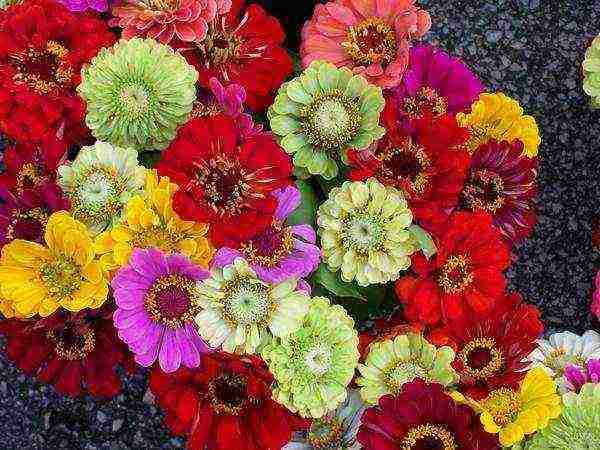 Zinnia is exactly the plant that can best decorate the site with minimal effort on your part.
Zinnia is exactly the plant that can best decorate the site with minimal effort on your part.
Zinnia is a plant belonging to the Asteraceae family. This flower owes its name to Karl Lineus, who in 1759 named it in honor of the director of the botanical garden, Johann Zinna.
Zinnia belongs to the genus of perennial and annual grasses, grows rather quickly and is a cross-pollinated plant. Depending on the variety, it can have an erect or spreading stem, or form a small bush. Ranges from 0.15 to 1.1 m in height. Powerful sturdy stem is covered with hard fibers.Elongated oval-shaped leaves sit on it, which are whorled or opposite.
On a note! The stalk of the zinnia is quite strong, which is why it does not need a garter (except for special weather conditions - strong winds or rainstorms), and cut flowers remain fresh for 1-1.5 weeks!
Zinnia is unpretentious, but in order for it to bloom as luxuriantly and abundantly as possible, it needs a lot of sunlight. For this reason, it is recommended to plant the plant in a warm, sunny area, protected from drafts. He does not like high humidity - watering should be rare, but at the same time abundant.
Bloom
Zinnia blooms incredibly effectively, forming complex large inflorescences at the ends of the stems. Their diameter can be up to 15 cm, and they consist of two types of flowers. The first type is the outer flowers, rather large, ligulate, their shape can be elongated-oval, elongated or in the form of a tube, which sometimes bifurcates at the end. The second type is tubular flowers. They are much smaller and generally tubular. They are located in the inner part of the inflorescence.
Zinnia flowers are extremely varied in color. They can be white, cream, red, scarlet, burgundy, orange, bright yellow, pinkish, purple, and even purple. Only blue is missing.
The flowering period of zinnia falls approximately 55-65 days after sowing in the ground and lasts until late autumn. Individual inflorescences are able to "live" for 3 days.
Garden classification
There are 4 main types of zinnias:
- graceful;
- narrow-leaved;
- fine-flowered;
- linearis.
Moreover, according to the garden classification, these species are divided into 3 subspecies: tall zinnias, the stem length of which is from 60 to 90 cm, medium-sized - from 0.35 to 0.55 m and undersized with a stem from 0.15 to 0.30 m.
Plants from the first subspecies are bred, as a rule, for a cut, and in general they look quite cumbersome in a flower garden. Low-growing zinnias are more versatile, as in the process of growth they form neat bushes, which are great for a flower garden, and for growing in pots, and for cutting.
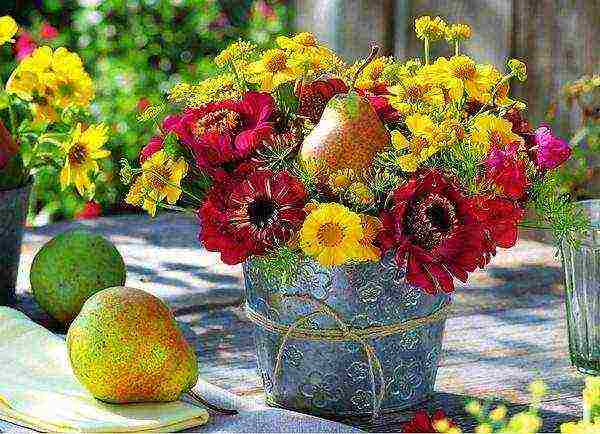 Low-growing zinnias produce the most colorful bouquets.
Low-growing zinnias produce the most colorful bouquets.
Graceful zinnia is the most common species and is most commonly grown for cutting. It has a powerful stem, large leaves and luxurious semi-double inflorescences measuring 12 cm in circumference.
On a note! The modern graceful zinnia has rather dense petals, which strikingly distinguishes it from the plant that appeared at the end of the 18th century. It had small inflorescences and it fully corresponded to its name - graceful!
Currently, zinnia graceful has a huge number of varieties, which are divided into separate groups.
- Dahlia (dahlia) zinnia. This is the most common group. Its representatives are characterized by large inflorescences - from 11 to 14 cm in diameter, and in the process of growth forms a large bush, which can be up to 1.2 m in height. In this case, the bushes are both powerful and spreading, and very compact. Dahlia zinnia, as you can see in the next photo, has tongue flowers with a rounded edge. They are located in the form of tiled masonry - they are found one on top of the other.
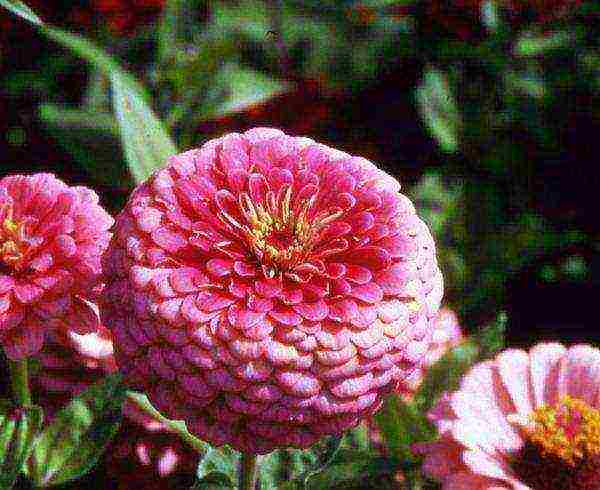 Dahlia zinnia has densely double inflorescences of a hemispherical shape, below the flowers are somewhat flattened
Dahlia zinnia has densely double inflorescences of a hemispherical shape, below the flowers are somewhat flattenedOn a note! Tall dahlia zinnias are striking in their beauty. Among them, the most famous varieties are Denariz Giants, Russian Size F1 and Zinnia California Giant. The diameter of their inflorescences is 15 cm, and the height of the stem reaches 1.2 m. The shade of the baskets can be varied, both monochromatic and two-colored. These varieties, like other tall zinnias, are grown for cutting, and they stand in water for up to 20 days.
- Chrysanthemum flowers. Such zinnias have a shorter stem - from 40 to 80 cm.The size of their baskets is quite large - 8-16 cm.The varieties that belong to this species are characterized by the pure color of the inflorescences. Reed flowers are always twisted in length into a tube or curled like a curl.
- Pompom. Zinnias, which belong to this species, are usually bushy and bloom very profusely. They are frost-hardy and produce lush inflorescences from early summer to late October. It can take up to a month for a single flower to bloom.
- Fantasy. The plant is compact, neat, spherical in shape. It can reach a height of 0.65 m. The flowers are loose, 8-10 cm in diameter. The petals are narrow, sometimes bifurcated at the ends, can be curved or twisted, which is why the baskets look like "shaggy". Representatives of this variety can have a wide variety of colors. Flowering begins in mid-June and lasts until frost.
Zinnia angustifolia
The most unpretentious in cultivation and care is narrow-leaved zinnia. It has simple flowers that are in no way inferior in beauty to the above group. Their shade is often yellow or deep orange. The bushes are very beautiful spherical in shape, small and often their height does not exceed 0.5 m.
Narrow-leaved zinnia cannot boast as many varieties as graceful, and most representatives are very similar in appearance to marigolds.
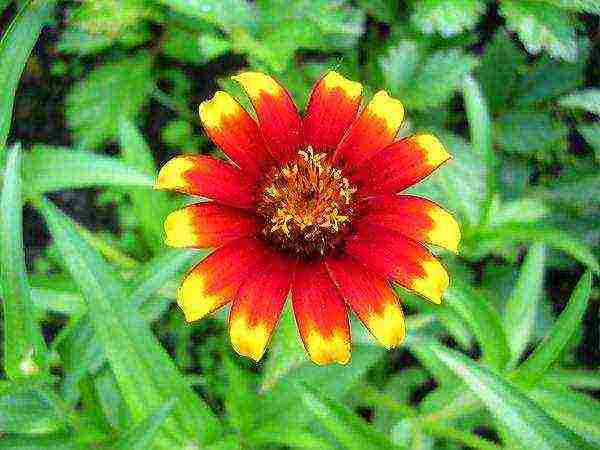 Zinnia angustifolia
Zinnia angustifolia
This type is most often found in landscape flower beds. Its bushes are small - up to 0.6 m in height. The stalk is thin, geniculate, and has a slightly reddish tint. Inflorescences are small - no wider than 3 cm, flowers are narrow with twisted ends. Their shade is usually purple.
In the next photo you can see what fine-flowered zinnia looks like.
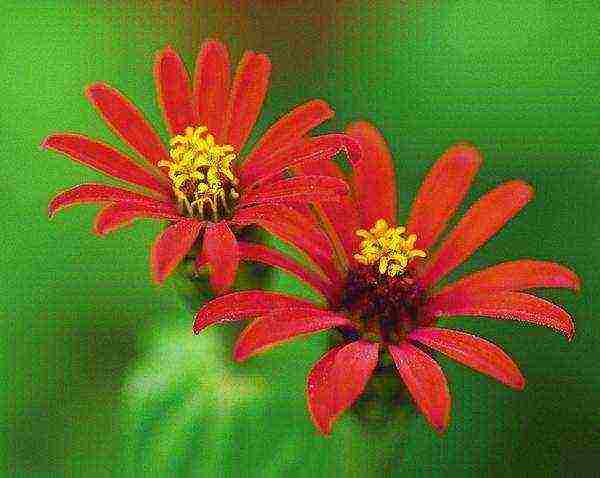 Variety "Red spider" Linearis
Variety "Red spider" Linearis
Quite often, zinnia linearis is confused with fine-flowered zinnia, since it has the same thin and sharp leaves. This species is one of the smallest of all cultivated. The branching bush has an almost spherical shape and grows no more than 35 cm in height.
During the flowering period, the linearis produces small inflorescences with yellow reed flowers. It is most suitable for growing in small containers or pots, and looks great on alpine slides and miniature flower beds.
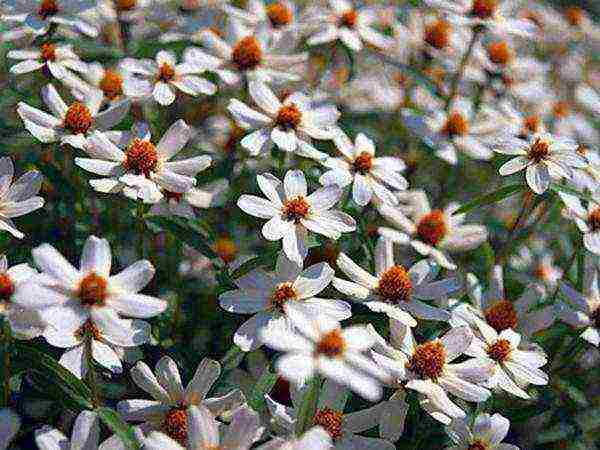 Zinnia linearis Popular varieties
Zinnia linearis Popular varieties
Represented by four main types, zinnia has incredible varieties, and therefore is easily able to justify the highest demands of modern landscape designers.
Undersized
Among the undersized zinnias, you can find both an elegant variety and a narrow-leaved one. The following miniature varieties are very fond of many flower growers:
- Series "Lilliput" - double zinnia, which gives rather large (about 10 cm in circumference) dome-shaped inflorescences. The bush is of medium height - about 0.5 m. It blooms for a long time and profusely.
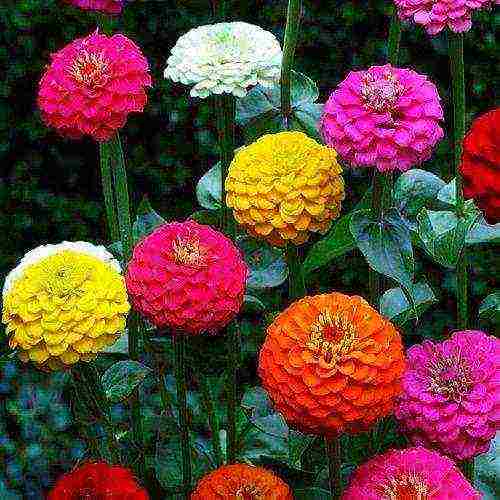 Zinnia "Lilliput"
Zinnia "Lilliput" - Rotcopchen, or Little Red Riding Hood, is one of the most sought-after varieties of graceful pompom zinnias. The plant got its name due to the dense red color of the petals, which, even under the strong rays of the sun, do not lose their saturation. "Little Red Riding Hood" is a short bush, the height of which can be 0.55 m and has a spherical shape. Covered with dense inflorescences - rounded or in the form of a truncated cone.
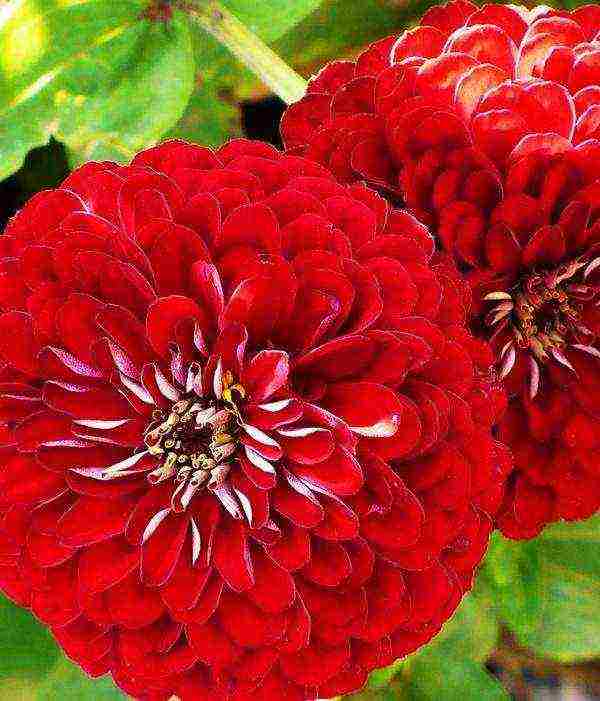 .Variety "Rotcopchen"
.Variety "Rotcopchen" - "Tom-Thumb", or "Tom-Tamb" - this flower also belongs to the variety of graceful zinnia. Its bushes are small, up to 45 cm in height, the flowers are bright red. This variety is very similar to "Little Red Riding Hood", but its inflorescences are not so round - in this case, the shape is more flattened.
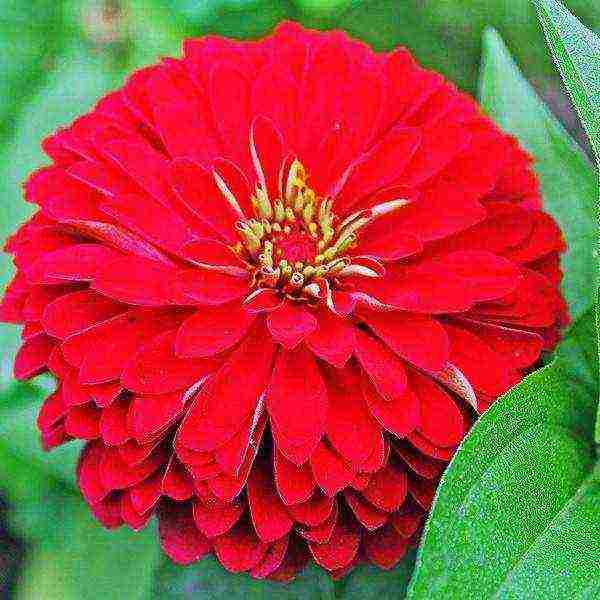 Variety "Tom-Tamb"
Variety "Tom-Tamb" - "Short-Staff" - is one of the most popular representatives of undersized zinnias. The height of the bush is often no more than 25 cm, but at the same time the inflorescences give rather large ones - about 10 cm in diameter. Flowers can be of different colors: coral, cherry, red and white.
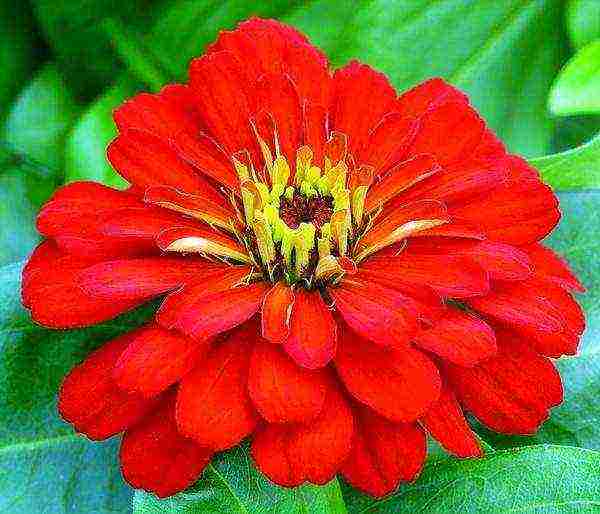 Variety "Short-Staff"
Variety "Short-Staff"
Dahlia Zinnia Varieties
Among the dahlia zinnias, the most popular are the following varieties:
- "Raspberry Monarch" - this variety gives an incredibly beautiful spreading bush, the height of which can be from 65 to 75 cm. During the flowering period, double inflorescences are formed, which can be either dense or loose. Their color is dark red, about 14 cm in diameter. A single flower can “live” from 17 to 26 days. The flowering period begins in early summer and lasts until the first frost.
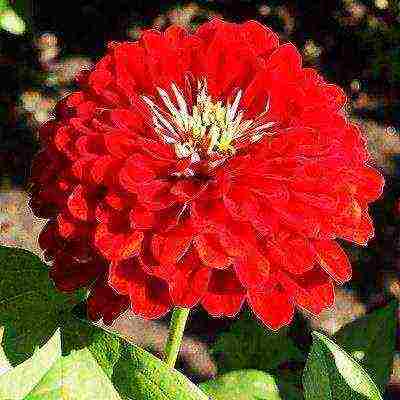 Variety "Raspberry Monarch"
Variety "Raspberry Monarch" - "Violet" is a sprawling bush, about 65-78 cm high. During the flowering period, dense inflorescences are formed, the diameter of which ranges from 11 to 13 cm. The inflorescences are terry, purple tones. It begins to bloom in July and this period lasts until frost.
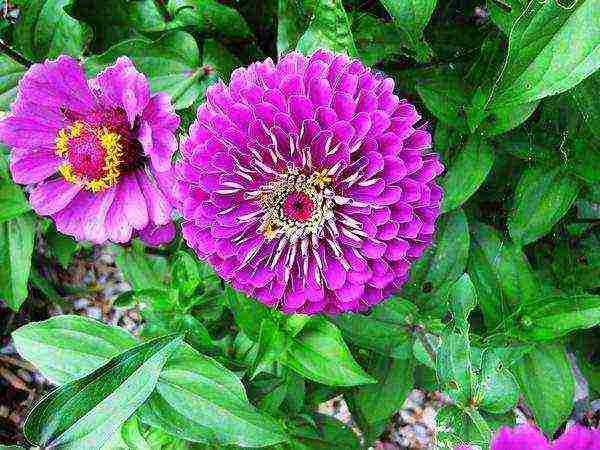 Variety "Violet"
Variety "Violet" - "Orange King" - the height of the plant is from 65 to 75 cm. The inflorescences are large, painted in a bright red-orange color. Their density is average, with a diameter of 13 to 15 cm. Flowers are double.
 One flower can bloom for 20-24 days
One flower can bloom for 20-24 days - "Lavender Queen" is a relatively tall plant, about 0.85 m. Sprawling Kustranik, dense, double inflorescences, about 12 cm in diameter. The shade is purple.
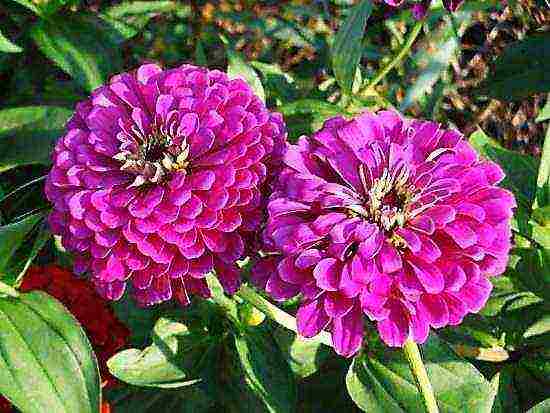 A single flower can bloom for up to three weeks.
A single flower can bloom for up to three weeks. - "Purple Prince" - the height of the bush ranges from 60-65 cm. During the flowering period, it gives large inflorescences with a purple tint. The flowering period lasts from the last decade of June to the first frost.
 "Purple Prince"
"Purple Prince" - "Envy" is a plant about 70 cm high, the inflorescence circumference is about 12-13 cm. The most popular variety that looks very advantageous in any flower bed, especially when surrounded by pink and purple flowers.
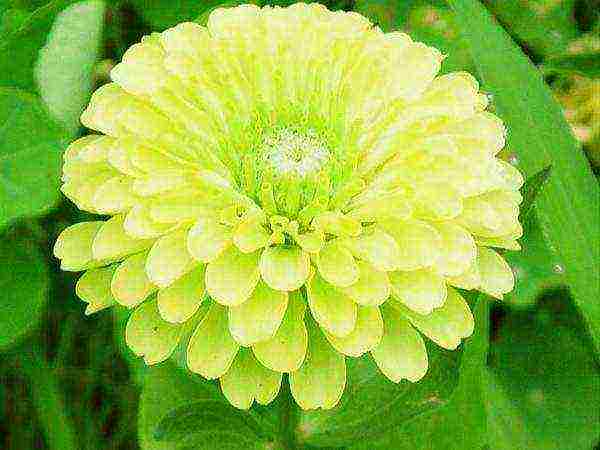 "Envy"
"Envy" - "Polar Bear" is a medium-sized bush - about 66-69 cm. A compact plant with dense double flowers. The inflorescences are dense, 14-15 cm in diameter. Painted in white with a greenish tint.
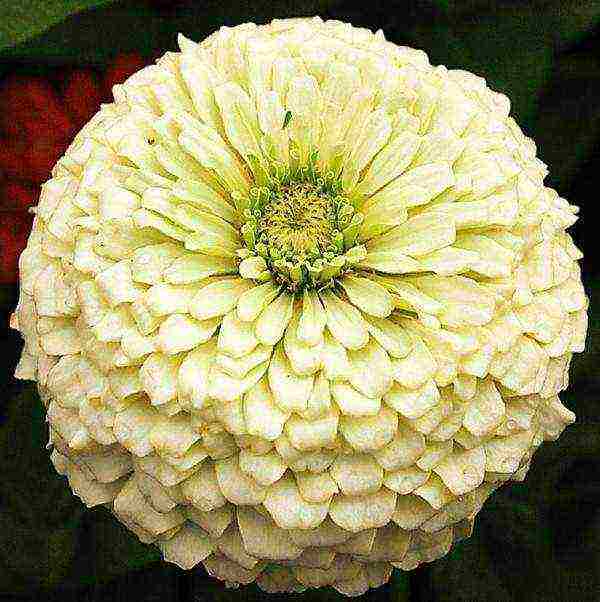 "Polar bear"
"Polar bear"
Varieties of zinnia angustifolia
The most common varieties of narrow-leaved zinnia are:
- "Persian Carpet" is a very beautiful plant, which in its appearance resembles an oriental carpet. The bush has a pattern composed of flowers of various colors: from bright yellow to rich brown.
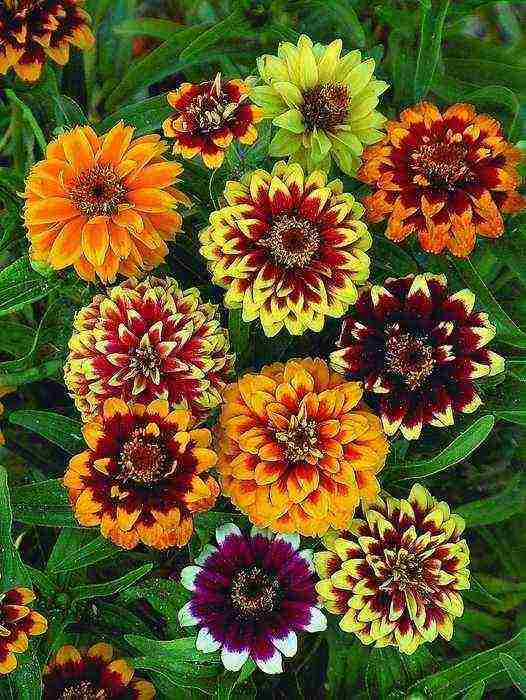 "Persian rug"
"Persian rug" - "Glorienshain" is a branched bush with double inflorescences. Blooms profusely, and throughout the entire flowering period. The flowers are bright orange, with a brown border visible at the tips.
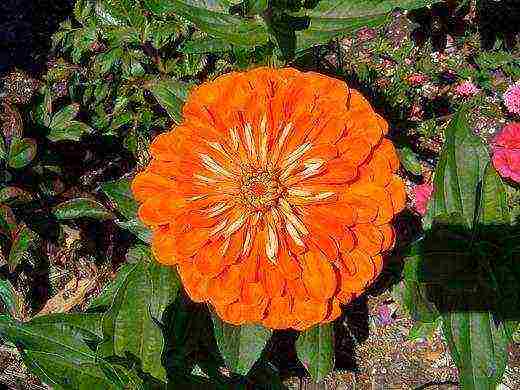 Glorienshine
Glorienshine - "CandyStrip" is somewhat similar to the "Persian Carpet" variety. He also has a second name "Tiger". The inflorescence petals are striped, which is why this plant looks great in a flower bed.
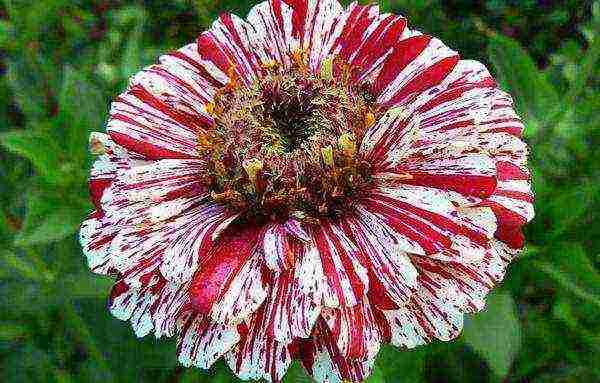 "CandiStrip"
"CandiStrip"
Hybrid varieties
The largest number of hybrid plants was obtained by crossing the graceful and narrow-leaved zinnia. Such a tandem gives very expressive bushes with incredibly lush dense caps and a bright pattern. Among the hybrids:
- series "ProfusionMixed" - plant height ranges from 30 to 35 cm. The bush is dotted with small flowers that are very similar to chamomile. However, their color may be different.
- Series "Carousel" - a medium-sized bush, about 60 cm high. Flowers are large, double, bicolor inflorescences. The petals are tapered at the ends.
- "Shaggi Dog" - small leaves twisted into tubes on the bushes. Leaves "look" down.
- "PepermintStick" is a very interesting hybrid, the petals of the inflorescences of which are painted in a bright yellow-red color.
- "Envi" - the bush has a fairly large light green foliage and a very expressive head of flowers.
- "Magellan" is a relatively small plant - about 35 cm in height. Inflorescences are densely double dahlia, their diameter is about 10 cm.The color is coral, pink, orange, salmon, cherry, red, yellow.
- The Swizzle series, represented by two varieties - Cherry Ivory, whose flowers have a creamy shade on the tips of the tongues, and ScarletYelow, with bright red flowers with a yellow border on the tips.
Bouquet varieties
Zinnia is a unique plant that can be grown both outdoors and in small pots right at home. It behaves well when cut, and under the right conditions will stand in a bouquet for two weeks.
On a note! Zinnia is good because it has a very weak aroma, and therefore will not cause discomfort to those people who are susceptible to a flower smell!
If zinnia interests you exclusively as a bouquet flower, then we advise you to use a mixture of varieties for cutting. Among the most successful species in this regard will be the aforementioned zinnia "California Giants". The bushes can reach a meter in height and will give you large inflorescences of various colors. Among the representatives of this variety, you can see white and yellow specimens, cream and purple, reds and lilacs, as well as all shades of pink and orange. Such a bouquet can stand for at least 12 days.
 "California Giants"
"California Giants"
Zinnia cactus is also the most successful choice. Her bushes are quite tall - about 90 cm, and the flowers are great for cutting. Large inflorescences are found on straight, strong stems. It blooms for a long time - from the beginning of summer to September, and stands for quite a long time after cutting.
 Zinnia cactus grade "God of Fire" Flower garden zinnia
Zinnia cactus grade "God of Fire" Flower garden zinnia
But be that as it may, the most successful zinnia still looks on a flower bed, as you can see by looking at the following photos. Among the flower garden varieties, the following are the most popular:
- Variety series "PersianCarpetMixed" - zinnia Hage. It gives amazingly beautiful semi-double bicolor inflorescences. Here you can find red-white, red-yellow, red-orange and red-lemon combinations. Often, plants from this variety series are grown in huge tracts that resemble beautiful variegated carpets from afar.
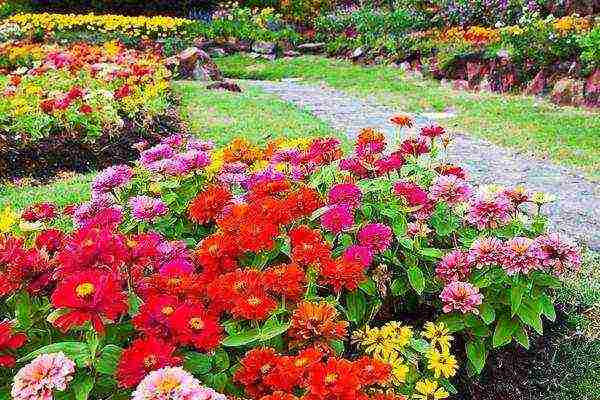 Picturesque flower bed with zinnias
Picturesque flower bed with zinnias - Any varieties of fine-flowered zinnia will look best in landscape flower beds. Its bushes with reddish stems and small flowers will be a real boon for all lovers of neat flower beds.
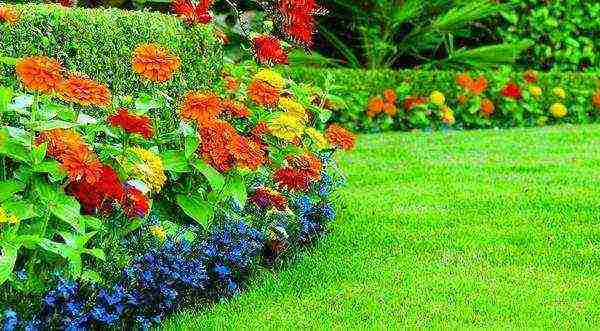 Garden decoration - long flower bed
Garden decoration - long flower bed - Zinnia Linearis is also suitable for growing in a flower garden, however it should be small. An alpine slide will be a great place for her. The most popular varieties for this case will be the varieties "Caramel" with a sharp center and dark yellow petals, as well as "Golden Eye" with small white inflorescences and a cheerful yellow center.
What's the best way to use zinnias?
Obviously, zinnia has a huge variety of varieties, which makes it easy to "fit" it into absolutely any landscape. At the same time, this flower can be placed in separate arrays: somewhere to create a picturesque carpet, somewhere to cover empty areas, somewhere to smooth out the transitions between cultures. And in any case, the zinnia will be in its place. What else to advise?
- Despite the fact that this plant looks great in a single planting, it is still better to place it in groups.
- If you are creating a mixborder, then tall varieties are best suited for it, but dwarf species are preferable for the border.
- Zinnia is able to recreate a rustic design by combining it with marigolds, asters, calendula, chrysanthemums and chamomiles.
- It can also be used to create a kind of "fence", for example, by planting bushes in a row between vegetables and herbs. So you get a bright spot on a somewhat "sad" garden background, which will perform not only a decorative function, but will attract pollinating insects.
- It is quite possible to plant zinnias along the path leading to your house, as well as around the garden building. Such linear plantings diversify the overall landscape picture and bring bright scenic notes to it.
Moscow, Russia, on the site since 11.01.2017
Have you read it? Don't forget to rate
(
estimates, average:
out of 5)


